Introduction
With news of the Z390 already looming during the launch of the Z370 and 8th-gen Core processors, it was understandable that ASUS had skipped that generation with a full stack release of the ROG line. There was no Gene nor Extreme during the Z370 release wave and for good measure. If ever the Z390 arrived for 8-core parts, that would’ve been the more logical choice. And fast-forward a few months later and we have that exact moment.
The ASUS ROG MAXIMUS XI EXTREME is the culmination of everything ASUS has developed in recent years in terms of motherboard design aimed at providing the best performance possible. With the Formula variant now aimed at watercooling enthusiasts seeking a more aesthetically pleasing build and the Extreme line focusing on delivering the most powerful platform available to maximize the current generation chipset, ASUS ROG strategy has basically given both models the flagship status.
In this review we’ll take a look at the performance flagship model of the Z390 range from ASUS, the ROG MAXIMUS XI EXTREME. A larger EATX motherboard featuring everything ASUS can cram in a single motherboard. Read on to find out more!
Features
- LGA1151 socket: Ready for 9th/8th Generation Intel® Core™ desktop processors.
- ROG Eco-System: ASUS-exclusive Aura Sync RGB lighting, including headers for both standard and addressable RGB strips
- Perfected cooling: Dedicated water-cooling zones, M.2 heatsink and flexible fan controls.
- ROG DIMM.2: Vertically-installed dual-M.2 expansion card with heatsink for maximum cooling and performance.
- 5-Way Optimization: Automated system-wide tuning, providing AI overclocking and cooling profiles tailor-made for your rig.
- Gaming connectivity: Aquantia 5G LAN and Intel Gigabit Ethernet onboard, four M.2, USB 3.1 Gen 2, Intel 2×2 802.11ac Wi-Fi with MU-MIMO support, LANGuard and GameFirst
- Gaming audio: High-fidelity sonics that draw you deeper into the action, with SupremeFX and Sonic Studio III
- Gaming durability: ROG patented pre-mounted I/O shield, ASUS SafeSlot, and premium components for maximum durability
About Intel Z390
It was already announced that Intel would be releasing a Z390 chipset a bit further in the year with the announcement of Z370 back in early 2018. That announcement materializes late in 2018 with the launch of the Intel Z390. Usually a processor would be the prelude to a new chipset but in this case, with the rumor already floating around that an 8-core Intel MSDT part would be released, it was already expected.
Not much has changed from Z390 to Z370. The new 9th-gen processors themselves work fine on Z370 chipset boards although Intel has been very adamant in utilizing the new Z390 boards with 8-core parts due to revisions on standards about how board makers should configure their VRMs.
In terms of changes, there’s only a few to note which includes Intel WIFI-AC having been baked directly into the board, the increase in USB3.1 Gen2 ports to 6. PCI-e lanes and HSIO config remains the same from last generation.
Coffee Lake Refreshed
The 9th-generation Intel Core processors mark the debut of the Core i9 in the mainstream market, previously only being made available in HEDT platform. This also sees Intel’s first 8-core offering for mainstream. One that would see prices skyrocket for their top parts. Factor in the current, ongoing supply issues that Intel has and its been a difficult time for the company and customers alike in terms of availability and pricing.
Going back to the processors themselves, Intel has announced three launch models: the Core i9-9900K, Core i7-9700K and the Core i5-9600K. Other SKUs have seen been announced including models without IGPs. Besides core count, one of the main changes that the 9th-gen Core processsors will is the total lack of Hyperthreading. Only the Core i9-9900K will have Hyperthreading amongst all currently announced models alongside its non-IGP counterpart.
As with the previous Coffee Lake release, the parts are forged in the 14nm fab process.
You can read more in our review of the Core i9 9900K and Core i7 9700K.
Note: Best viewed on desktop 1366x768 or higher.
| Core i9 | Core i7 | Core i5 | ||||||||||||
|---|---|---|---|---|---|---|---|---|---|---|---|---|---|---|
| i9-13900K | i9-13900KF | i9 13900 | i9 13900F | i9 13900T | i7-13700K | i7-13700KF | i7-13700 | i7-13700F | i7-13700T | i5-13600K | i5-13600KF | i5 13400 | i5 13400F | |
| TDP | 125 W | 125 W | 65 W | 65 W | 35 W | 125 W | 125 W | 65 W | 65 W | 35 W | 125 W | 125 W | 65 W | 65 W |
| Core Count | 24 (8P+16E) | 24 (8P+16E) | 24 (8P+16E) | 24 (8P+16E) | 24 (8P+16E) | 16(8P+8E) | 16(8P+8E) | 16(8P+8E) | 16(8P+8E) | 16(8P+8E) | 14(6P+8E) | 14(6P+8E) | 14(6P+8E) | 14(6P+8E) |
| Base Clock | 3.0 Ghz | 3.0 Ghz | 2.0 Ghz | 2.0 Ghz | 1.1 Ghz | 3.4 Ghz | 3.4 Ghz | 2.1 Ghz | 2.1 Ghz | 1.4 Ghz | 3.5 Ghz | 3.5 Ghz | 2.5 Ghz | 2.5 Ghz |
| TVB Single Core | 5.8 Ghz | 5.8 Ghz | 5.6 Ghz | 5.6 Ghz | N/A | N/A | N/A | N/A | N/A | N/A | N/A | N/A | N/A | N/A |
| Single Core Turbo | 5.4 Ghz | 5.4 Ghz | 5.3 Ghz | 5.2 Ghz | N/A | 5.3 Ghz | 5.3 Ghz | 5.1 Ghz | 5.1 Ghz | N/A | 5.1 Ghz | 5.1 Ghz | 4.6 Ghz | 4.6 Ghz |
| Turbo Boost Max 3.0 | 5.7 Ghz | 5.7 Ghz | 5.5 Ghz | 5.5 Ghz | 5.3 Ghz | 5.4 Ghz | 5.4 Ghz | 5.4 Ghz | 5.2 Ghz | 4.9 Ghz | 5.2 Ghz | 5.1 Ghz | N/A | N/A |
| Memory Support | DDR4/DDR5 | DDR4/DDR5 | DDR4/DDR5 | DDR4/DDR5 | DDR4/DDR5 | DDR4/DDR5 | DDR4/DDR5 | DDR4/DDR5 | DDR4/DDR5 | DDR4/DDR5 | DDR4/DDR5 | DDR4/DDR5 | DDR4/DDR5 | DDR4/DDR5 |
| DDR4 | 3200 MT/s | 3200 MT/s | 3200 MT/s | 3200 MT/s | 3200 MT/s | 3200 MT/s | 3200 MT/s | 3200 MT/s | 3200 MT/s | 3200 MT/s | 3200 MT/s | 3200 MT/s | 3200 MT/s | 3200 MT/s |
| DDR5 | 5600 MT/s | 5600 MT/s | 5600 MT/s | 5600 MT/s | 5600 MT/s | 5600 MT/s | 5600 MT/s | 5600 MT/s | 5600 MT/s | 5600 MT/s | 5600 MT/s | 5600 MT/s | 5600 MT/s | 5600 MT/s |
Specifications
- CPUIntel® Socket 1151 9th / 8th Gen Intel® Core™, Pentium® Gold and Celeron® Processors
Supports Intel® 14 nm CPU
Supports Intel® Turbo Boost Technology 2.0
* The Intel® Turbo Boost Technology 2.0 support depends on the CPU types.
* Refer to www.asus.com for CPU support list - ChipsetIntel® Z390
- Memory4 x DIMM, Max. 64GB, DDR4 4400(O.C)/4266(O.C.)/4133(O.C.)/4000(O.C.)/3866(O.C.)/3733(O.C.)/3600(O.C.)/3466(O.C.)/3400(O.C.)/3333(O.C.)/3300(O.C.)/3200(O.C.)/3000(O.C.)/2800(O.C.)/2666/2400/2133 MHz Non-ECC, Un-buffered Memory
Dual Channel Memory Architecture
Supports Intel® Extreme Memory Profile (XMP)
* Hyper DIMM support is subject to the physical characteristics of individual CPUs.
* Refer to www.asus.com for the Memory QVL (Qualified Vendors Lists). - GraphicIntegrated Graphics Processor- Intel® UHD Graphics support
VGA output support : HDMI port
– Supports HDMI with max. resolution 4096 x 2160 @ 30 Hz - Multi-GPU SupportSupports NVIDIA® 2-Way SLI™ Technology
Supports AMD 3-Way CrossFireX™ Technology - Expansion SlotsSocket 1151 for 9th / 8th Gen Intel® Core™, Pentium® Gold and Celeron® processors
2 x PCIe 3.0/2.0 x16 (x16 or dual x8)
Intel® Z390 Chipset
1 x PCIe 3.0/2.0 x16 (max at x4 mode) *1
1 x PCIe 3.0/2.0 x1 - StorageSocket 1151 for 9th / 8th Gen Intel® Core™, Pentium® Gold and Celeron® processors :
1 x ROG DIMM.2 Module support(CPU_DIMM.2), with M key, type 2242/2260/2280/22110 storage devices support (PCIE 3.0 x 4 mode)*2
Intel® Z390 Chipset :
1 x M.2 Socket 3, with M key, type 2242/2260/2280 storage devices support (SATA & PCIE 3.0 x 4 mode)*3
1 x M.2 Socket 3, with M key, type 2242/2260/2280/22110 storage devices support (PCIE 3.0 x 4 mode)
6 x SATA 3Gb/s port(s)
Support Raid 0, 1, 5, 10
Intel® Optane™ Memory Ready - LANAquantia AQC111C 5G LAN
Intel® I219V, Dual interconnect between the Integrated Media Access Controller (MAC) and Physical Layer (PHY)
Anti-surge LANGuard
ROG GameFirst Technology - Wireless Data NetworkIntel® Wireless-AC 9560
Wi-Fi 802.11 a/b/g/n/ac
Supports dual band frequency 2.4/5 GHz
Supports MU-MIMO
Supports channel bandwidth: HT20/HT40/HT80/HT160 - BluetoothBluetooth® 5.0
- AudioROG SupremeFX 8-Channel High Definition Audio CODEC S1220
– Impedance sense for front and rear headphone outputs
– Supports : Jack-detection, Multi-streaming, Front Panel Jack-retasking
– High quality 120 dB SNR stereo playback output and 113 dB SNR recording input
– SupremeFX Shielding Technology
– ESS® ES9023P
– Supports up to 32-Bit/192kHz playback *4
Audio Feature :
– Gold-plated jacks
– Optical S/PDIF out port(s) at back panel
– Sonic Radar III
– Sonic Studio III + Sonic Studio Link - USB PortsIntel® Z390 Chipset :
1 x USB 3.1 Gen 2 front panel connector port(s)
Intel® Z390 Chipset :
4 x USB 3.1 Gen 2 port(s) (4 at back panel, )
Intel® Z390 Chipset :
8 x USB 3.1 Gen 1 port(s) (4 at back panel, , 4 at mid-board)
Intel® Z390 Chipset :
4 x USB 2.0 port(s) (4 at mid-board)
ASMedia® USB 3.1 Gen 1 controller :
2 x USB 3.1 Gen 1 port(s) (2 at back panel, ) - ROG Exclusive FeaturesReTry Button
Safe Boot Button
Start Button
LN2 Mode
Extreme Engine Digi+ :
– MicroFine Alloy Chokes
– 10K Black Metallic Capacitors
Mem TweakIt
Extreme Tweaker
ROG Exclusive Software
– Mem Tweakit
– RAMCache III
– RAMDisk
– CPU-Z
– GameFirst V
– Sonic Studio III + Sonic Studio Link
– Sonic Radar III - Special FeaturesASUS Dual Intelligent Processors 5-Way Optimization by Dual Intelligent Processors 5 :
– 5-Way Optimization tuning key perfectly consolidates TPU Insight, EPU Guidance, DIGI+ VRM, Fan Expert 4, and Turbo App
LiveDash OLED
SafeDIMM slot
AURA :
– Aura Lighting Control
– Aura RGB Strip Headers
– Aura Lighting Effects Synchronization with compatible ASUS ROG devices
– Aura Addressable Strip Header(s)
ASUS Exclusive Features :
– USB BIOS Flashback
– MemOK! II
– AI Suite 3
– Ai Charger
– Armoury Crate
– Pre-mounted I/O Shield
– ASUS NODE: hardware control interface
– BUPDATER
– BIOS Flashback Button
– Clear CMOS Button
– Reset Button
ASUS EZ DIY :
– ASUS CrashFree BIOS 3
– ASUS EZ Flash 3
ASUS Q-Design :
– ASUS Q-Code
– ASUS Q-LED (CPU, DRAM, VGA, Boot Device LED)
– ASUS Q-Slot
– ASUS Q-DIMM
– ASUS Q-Connector
Overclocking Protection :
– ASUS C.P.R.(CPU Parameter Recall)
OptiMem II - Back I/O Ports1 x HDMI
1 x LAN (RJ45) port(s)
4 x USB 3.1 Gen 2 (red) (1 x Type-C+3 x Type-A)
6 x USB 3.1 Gen 1
1 x Optical S/PDIF out
1 x Clear CMOS button(s)
1 x USB BIOS Flashback Button(s)
1 x ASUS Wi-Fi Module
5 x LED-illuminated audio jacks
1 x AQC-111C 5G LAN port - Internal I/O Ports1 x W_PUMP+ 1
1 x W_PUMP+ 2
1 x WB_SENSOR
2 x Aura Addressable Strip Header(s)
2 x Aura RGB Strip Headers
2 x USB 3.1 Gen 1(up to 5Gbps) connector(s) support(s) additional 4 USB 3.1 Gen 1 port(s)
2 x USB 2.0 connector(s) support(s) additional 4 USB 2.0 port(s)
1 x M.2 Socket 3 with M key, type 2242/2260/2280 storage devices support (SATA & PCIE 3.0 x 4 mode)
1 x M.2 Socket 3 with M key, type 2242/2260/2280/22110 storage devices support (PCIE 3.0 x 4 mode)
6 x SATA 6Gb/s connector(s)
1 x CPU Fan connector(s) (1 x 4 -pin)
1 x CPU OPT Fan connector(s) (1 x 4 -pin)
2 x Chassis Fan connector(s) (2 x 4 -pin)
1 x Thunderbolt header(s)
1 x 24-pin EATX Power connector(s)
2 x 8-pin EATX 12V Power connectors
1 x 4-pin EZ_PLUG Power connector(s)
1 x Front panel audio connector(s) (AAFP)
1 x 5-pin EXT_FAN(Extension Fan) connector
1 x MemOK! II switch(es)
1 x Slow Mode switch(es)
9 x ProbeIt Measurement Points
1 x Reset button(s)
1 x BIOS Switch button(s)
1 x Node Connector(s)
1 x LN2 Mode jumper(s)
1 x Safe Boot button
1 x ReTry button
1 x System panel connector
1 x W_IN header
1 x W_OUT header
1 x W_FLOW header
1 x Thermal sensor connector
1 x Start button
1 x USB 3.1 Gen 2 front panel connector
1 x DIMM.2 Slot supports 2 M.2 drives (2242-22110)
1 x RSVD Switch
8 x Radiator Fan Headers - AccessoriesUser’s manual
1 x ROG logo plate sticker
4 x SATA 6Gb/s cable(s)
3 x M.2 Screw Package
1 x ASUS 2T2R dual band Wi-Fi moving antennas (Wi-Fi 802.11a/b/g/n/ac compliant)
1 x Fan Extension Card (3 x 4-pin fan out)
1 x Fan Extension card screw pack
1 x Fan Extension card cable
1 x SLI HB BRIDGE(2-WAY-M)
1 x ROG big sticker
1 x Q-Connector
1 x Extension Cable for RGB strips (80 cm)
1 x Extension cable for Addressable LED
3 x Thermistor cable(s)
1 x USB drive with utilities and drivers
1 x ROG coaster(s)
2 x ROG weave SATA 6G cable
1 x ROG DIMM.2 with heatsink
1 x M.2 Pad for ROG DIMM.2 - BIOS2 x 128 Mb Flash ROM, UEFI AMI BIOS, PnP, DMI3.0, SM BIOS 3.1, ACPI 6.1
- ManageabilityWOL, PXE
- Operating SystemWindows® 10 64-bit
- Note*1 When SATA56 is enabled, PCIE x 16_3 will run at x2 mode.
*2 The DIMM.2 Slot (M.2_1/2) are disabled by default. Please adjust BIOS settings to enable DIMM.2 Slots.
When DIMM.2 slot is enabled, PCIex16_1 will run at x8 mode. Please refer to BIOS manual for further information.
DIMM.2 slot IRST is only supported when using Intel SSD.
*3 When M.2_1 socket 3 is operating in SATA mode, SATA port 2 will be disabled.
*4 Due to limitations in HDA bandwidth, 32-Bit/192kHz is not supported for 8-Channel audio.
Packaging & Content
ASUS has been subtly tweaking its packaging over the last generations of motherboards and this time around, the change is a bit more defined yet still subtle. The new ROG motherboard packaging now don a more distinct black styling with abstract panel lines adorning the main sides. The main cover has holographic prints in bold for the model names with minimal prints on the rest of the front.
The side are now a brighter shade of red, a truer red than what we’ve been used to seeing since the early Maximus or Rampage releases. The narrow sides now have a bright red print with the eye logo of ROG printed on 1 side similar to Jordan brand packaging style.
At the back we have a detailed breakdown of the features and specs of the motherboard. There’s also detailed highlights of some of the key features of the board at the back.
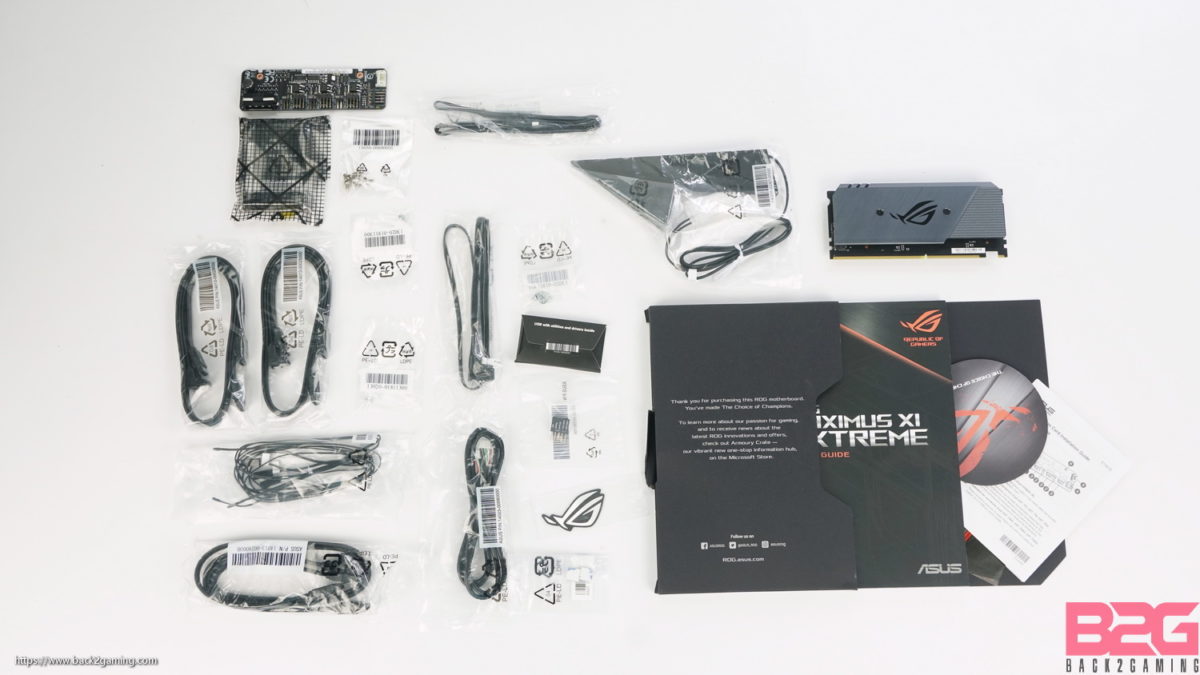
Inside the package we have the following:
- WIFI antenna
- Front panel Q-connector
- ROG SLI HB bridge
- 4x SATA cables
- 2x sleeved SATA cables
- M.2 screws
- 3x Thermistor cables
- Fan extension card
- Fan extension cable
- Fan extension screws
- ROG driver USB flash drive
- Manual
- Greeting card
- CableMod discount voucher
- Mounting adhesive pads for M.2
- ROG DIMM_2 M.2 riser module
- Logo sticker
- Large sticker sheet
- Cable for RGB strip
- Cable for addressable RGB LED
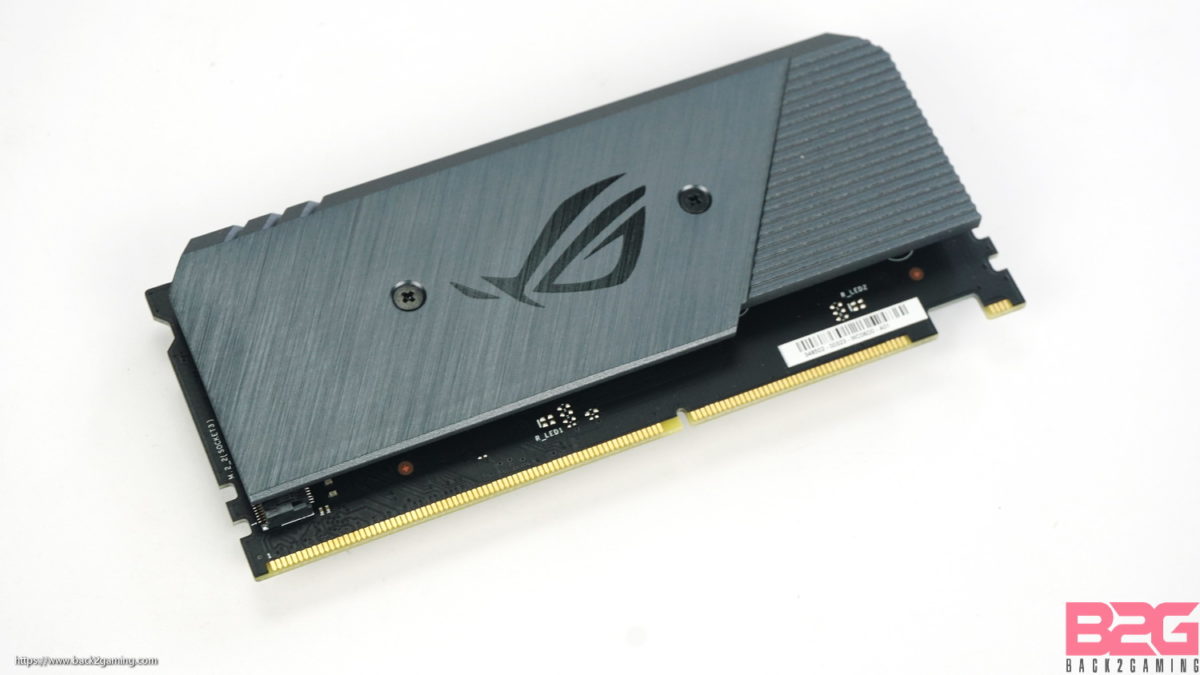
The DIMM_2 module is basically an M.2 riser that connectors to a proprietary slot on the motherboard which resembles, you guessed it, a DIMM slot. The latest iteration of this tech now features an integrated heatspreader. As more and more M.2 devices become faster and generate more heat, it makes sence to have great cooling especially if you want to keep them performing at their best.
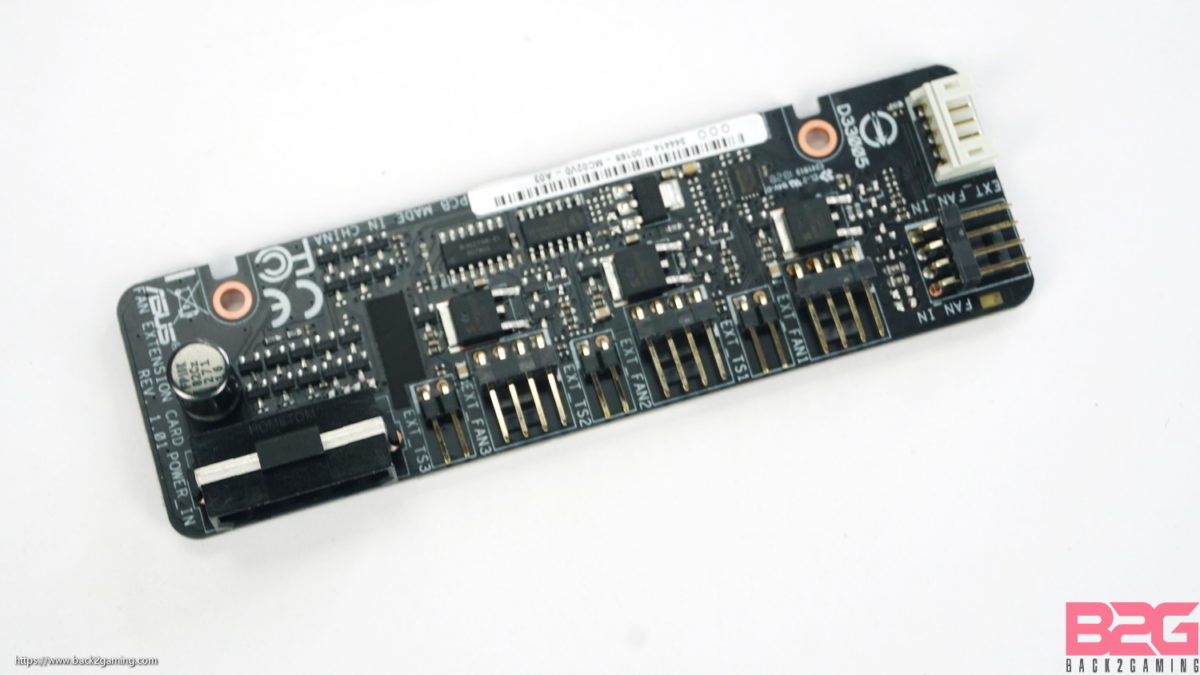
The fan extension card allows more fans to be connected to your system and be fully monitored and controlled via the motherboard. This is especially handy when you’re running a custom waterloop of more than 2x 360mm radiators and you’d like the motherboard to handle all fan control duties.
Closer Look
First thing that would strike anyone holding this board is the sheer weight of it. There is just so much on the board that the dense heatsinks and backplate alone only account for a good portion of the overall weight. The PCB itself is quite thick and the plastic shroud are quite sturdy as well. Previous Extreme iterations have been very busy in terms of PCB layout and the Maximus XI Extreme has managed to dodge this trope by shifting some components around. First up we have the DIMM_2 slot for a pair of M.2 cards and underneath the PCH heatsink there’s also another pair of M.2 slots for you to use.
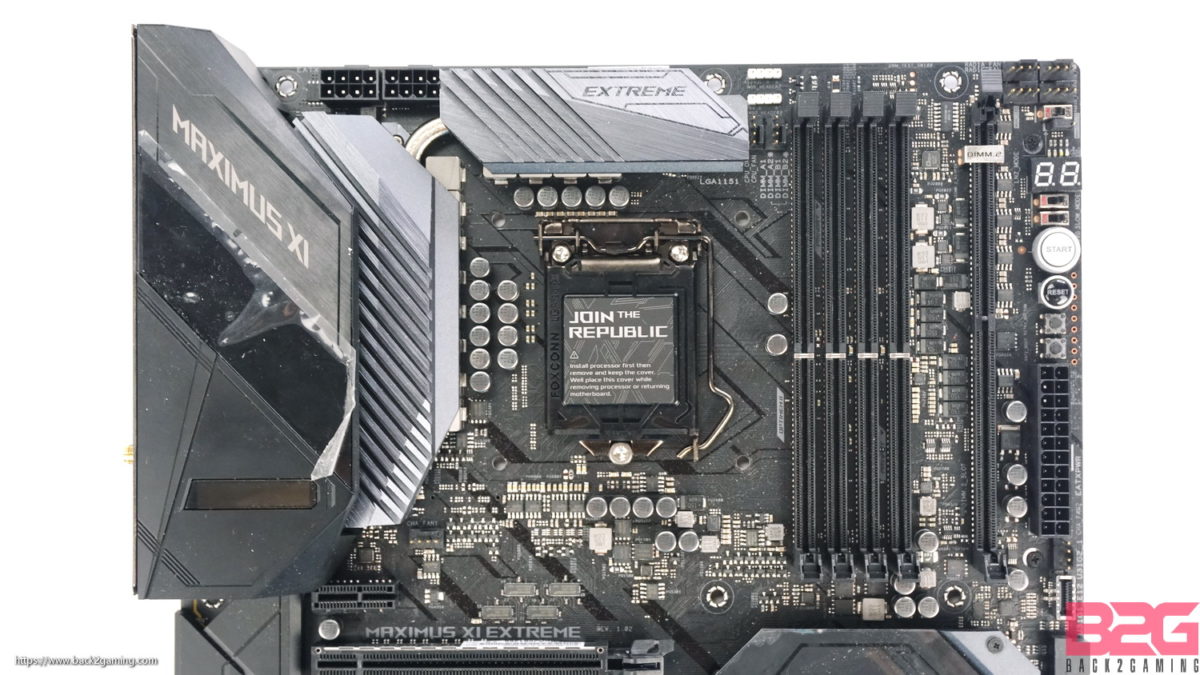
The upper half of the board features a lot of details with a ton of board components pretty much obscuring the silkscreen print on the motherboard PCB.
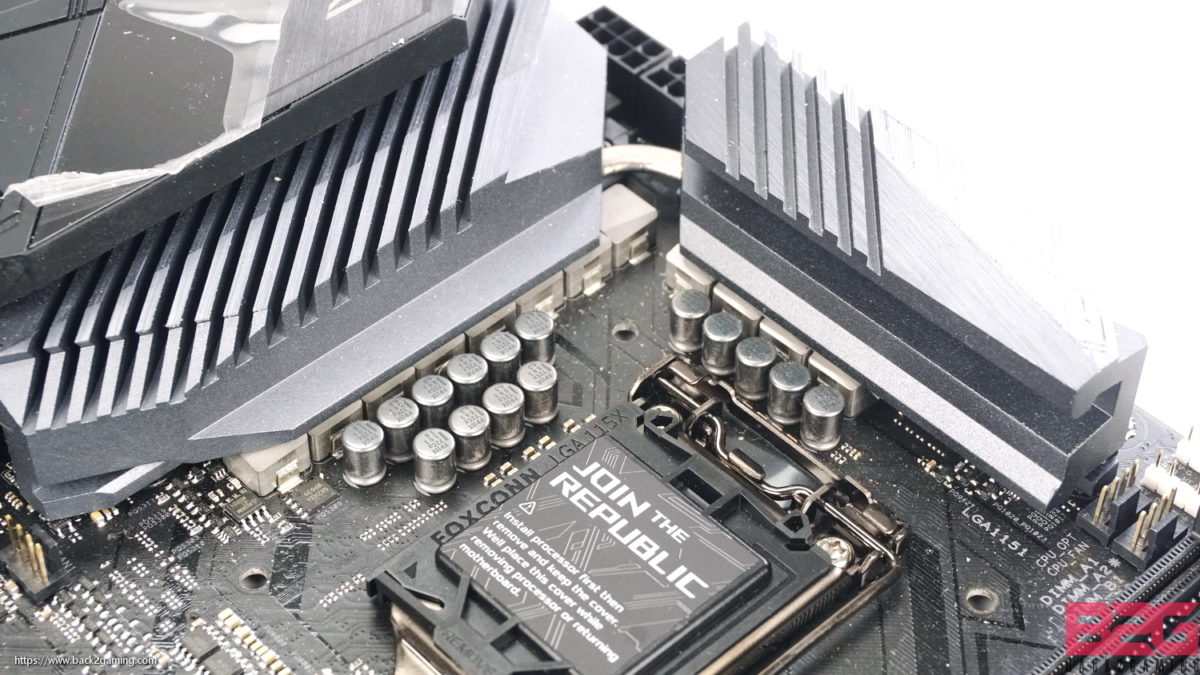
The ASUS MAXIMUS XI Extreme uses a 12-phase power delivery design cooled by a beefy heatsink connected by a heatpipe. ASUS did not include watercooling channels in the Max11Extreme VRM heatsink as they may have a partnership with EKWB for another monoblock similar to the Rampage VI Extreme. This allows a full coverage block to cool both VRMs and CPU at the same time for those interested in maximum performance under liquid cooling.
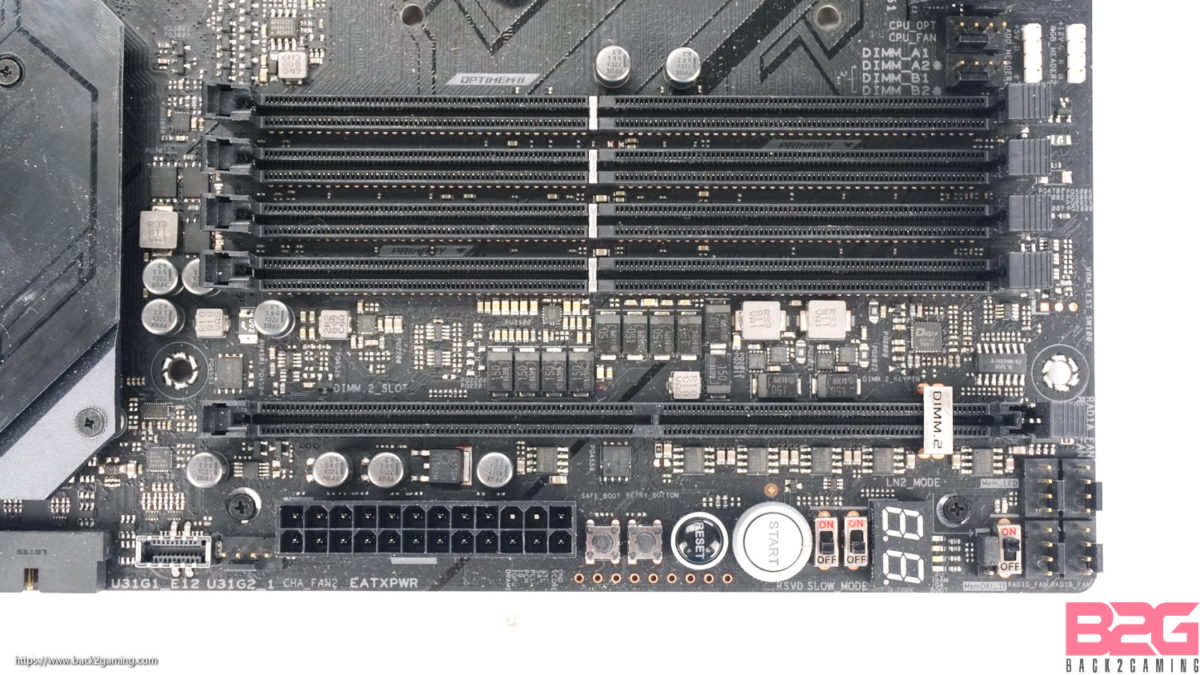
A topdown shot of the DIMM slot area shows us the cleanly laid out side of the Maximus XI Extreme complete with the onboard power buttons. If you look closely on the far edge you’d see the fan headers clumped up in one location and another pair of fan headers are tucked between the DIMM slot and VRM heatsink.
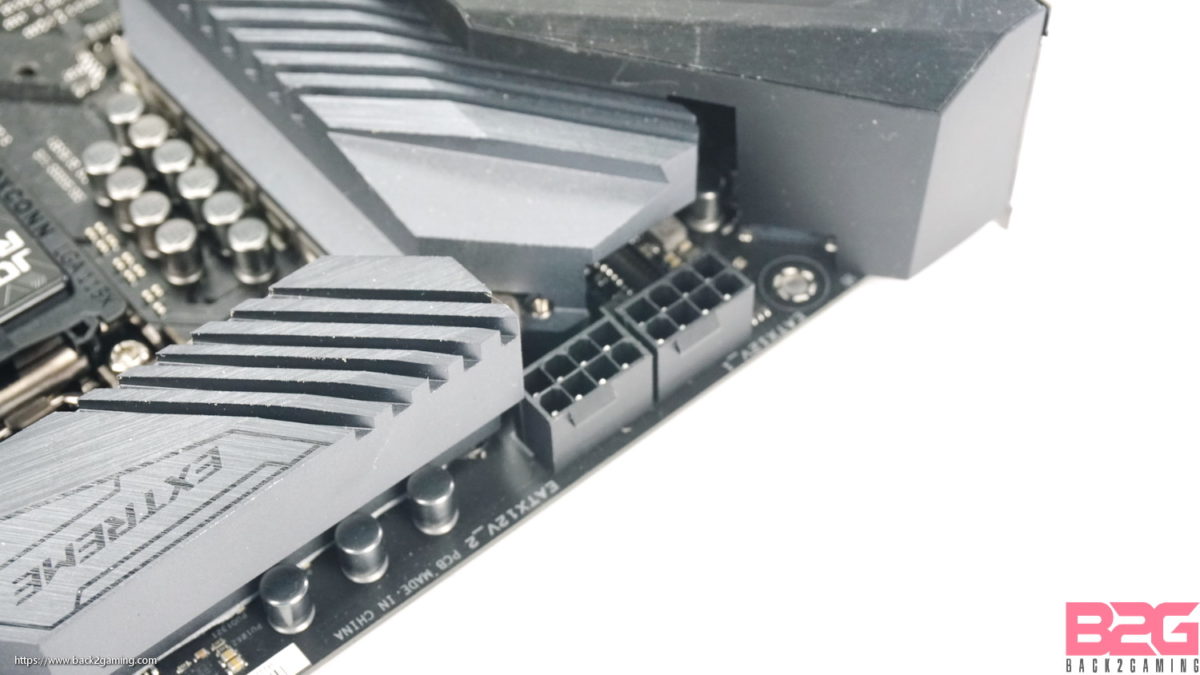
The Max11Extreme uses two 8-pin ATX EPS power connectors.
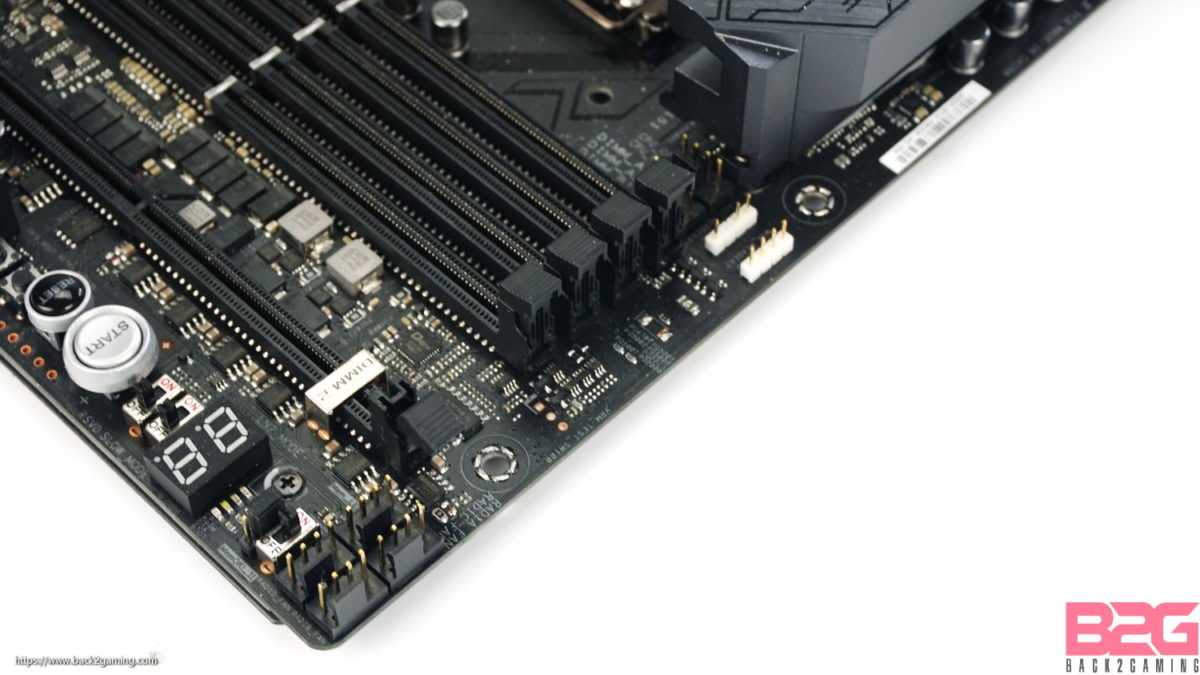
Just above the DIMM slots are the RGB headers for this motherboard.
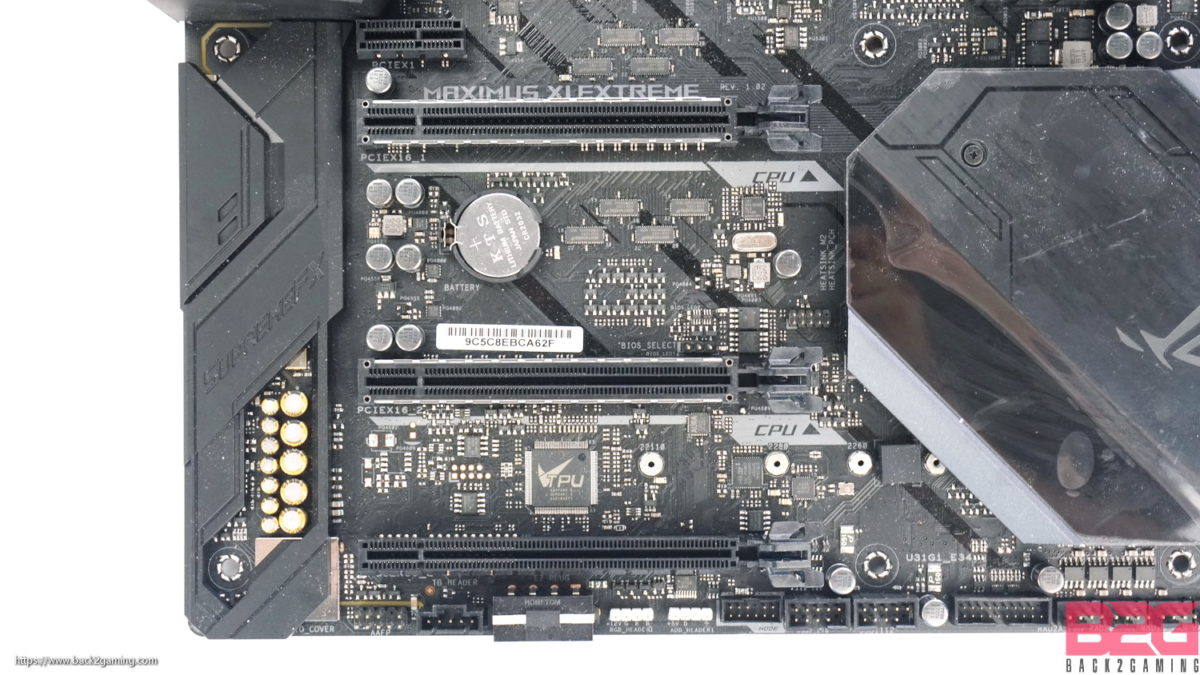
Moving over to the bottom half of the motherboard we get to see what we’re working with in terms of expansion slots. There’s two SecureSlot, reinforced PCIe x16 length slots for your graphics card which will run in x8/x8 configuration when populated. Underneath the PCH heatsink are two M.2 slots, one sits horizontally between the 2nd and 3rd PCIe x16 slot and the other one lays vertical along the right side of the motherboard.
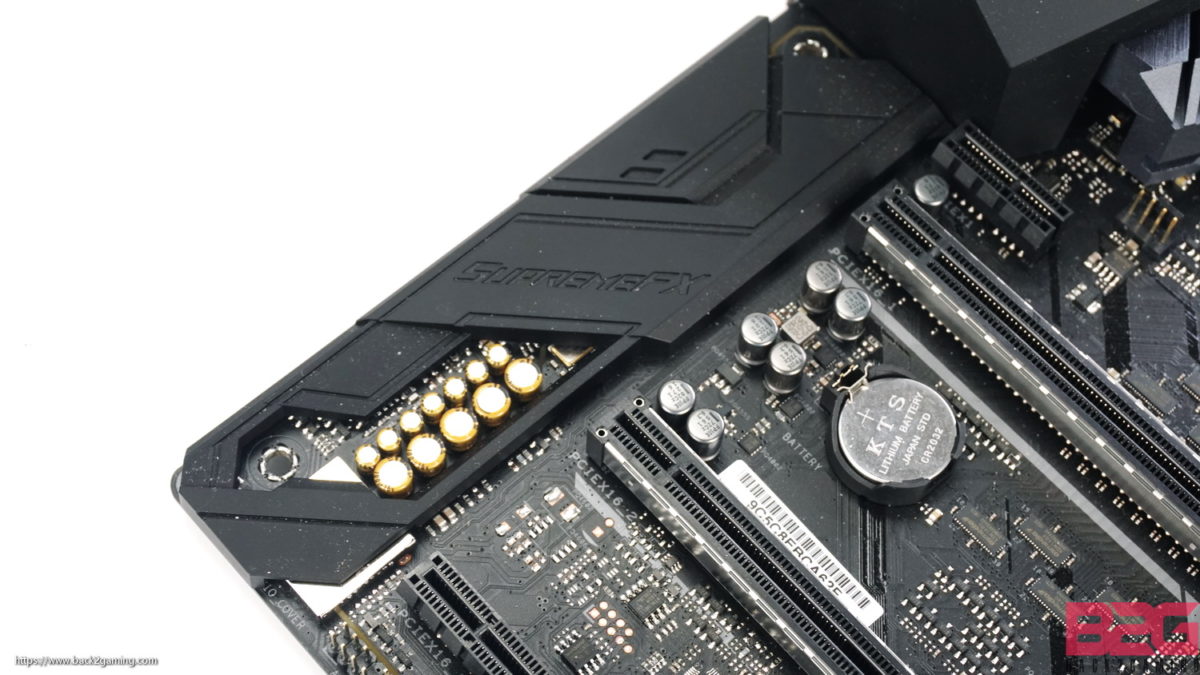
The motherboard, like everything else in this generation (well, almost), uses Realtek ALC1220 complimented by ASUS SupremeFX technology and an ESS ES9023P DAC.
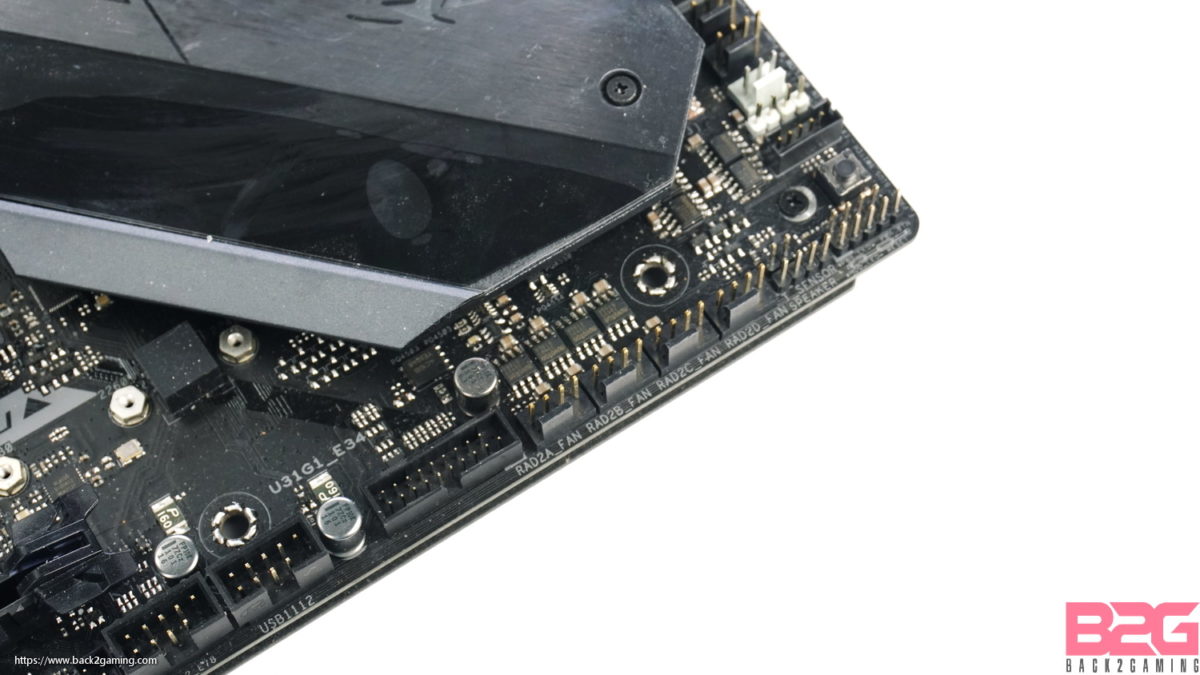
Like the upper edge of the board, the lower edge is also lined with a slew of fan headers.
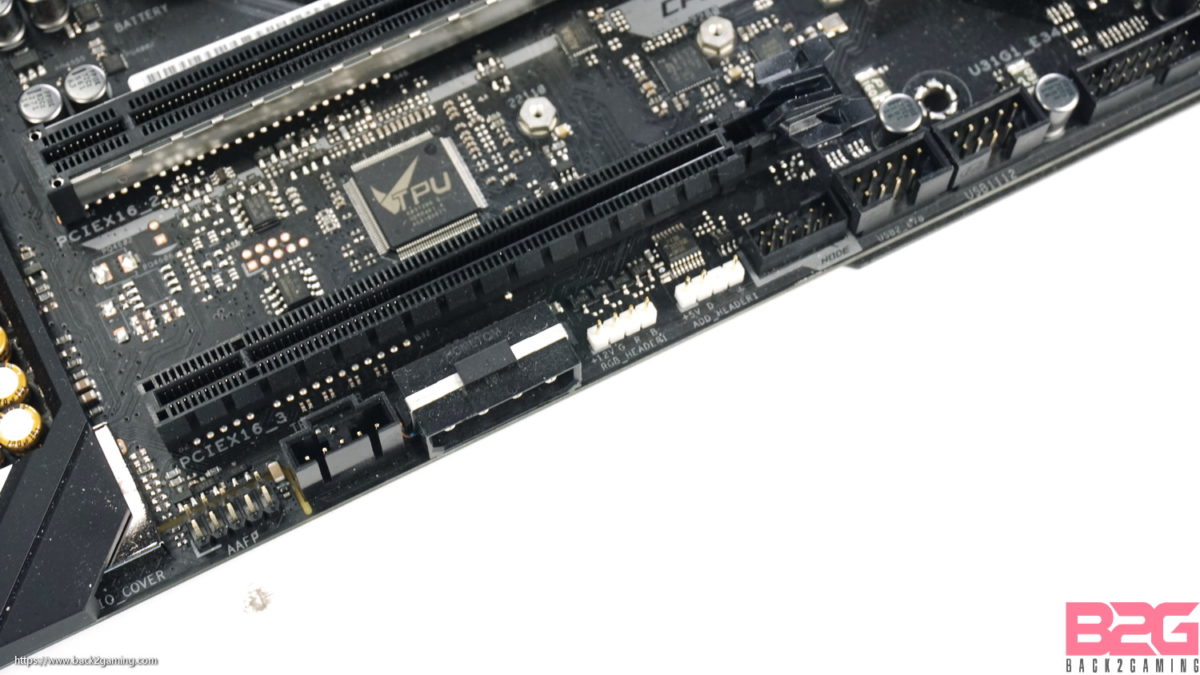
A couple more RGB connectors with other front panel connectors on the lower part.
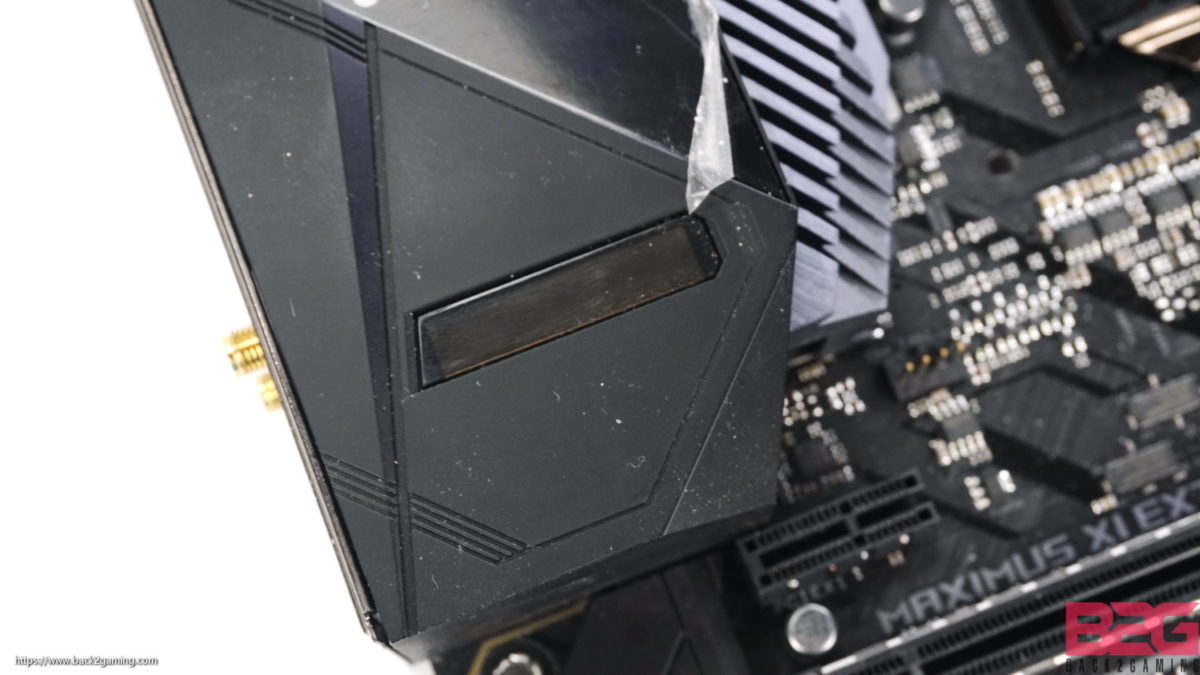
ASUS LiveDash OLED display is located on the rear I/O shroud. This little LCD screen can be configured to display a wealth of information including current temperature, current frequency, etc. you can also set it up to display a nice pixel image. By default the ASUS ROG logo animates on it. On bootup, it serves as the debug display and gives richer detail on what’s going on in bootup to help you in troubleshooting startup problems.
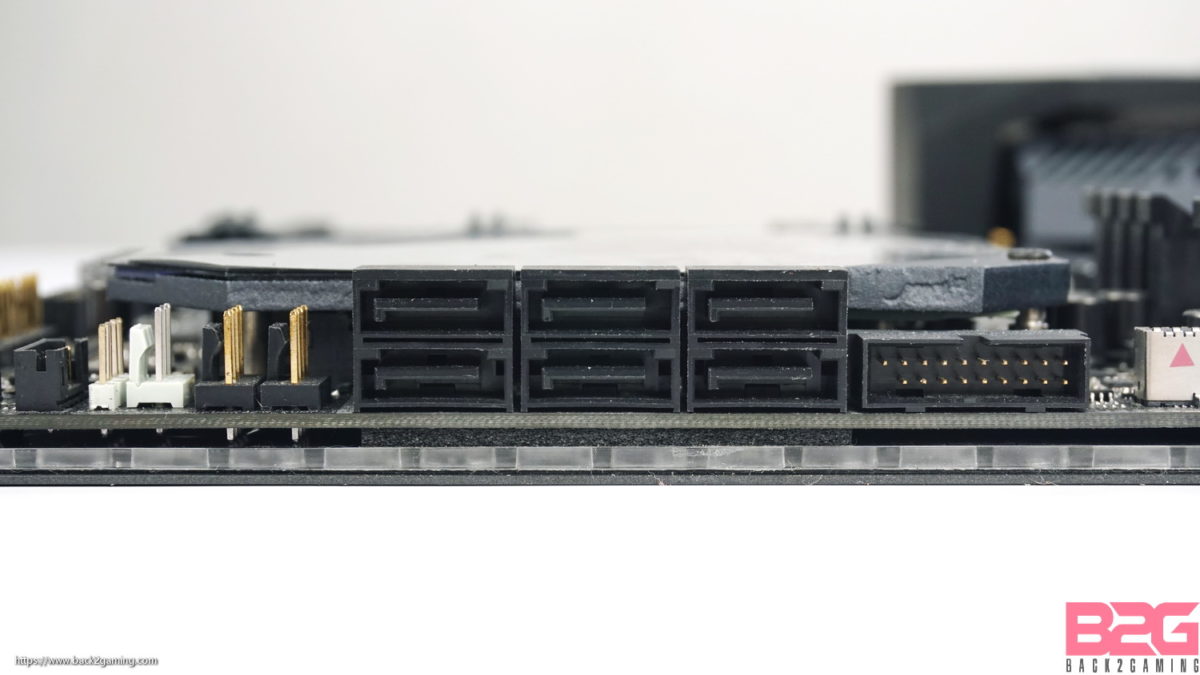
The ASUS ROG Maximus XI Extreme has 6 built-in SATA ports.
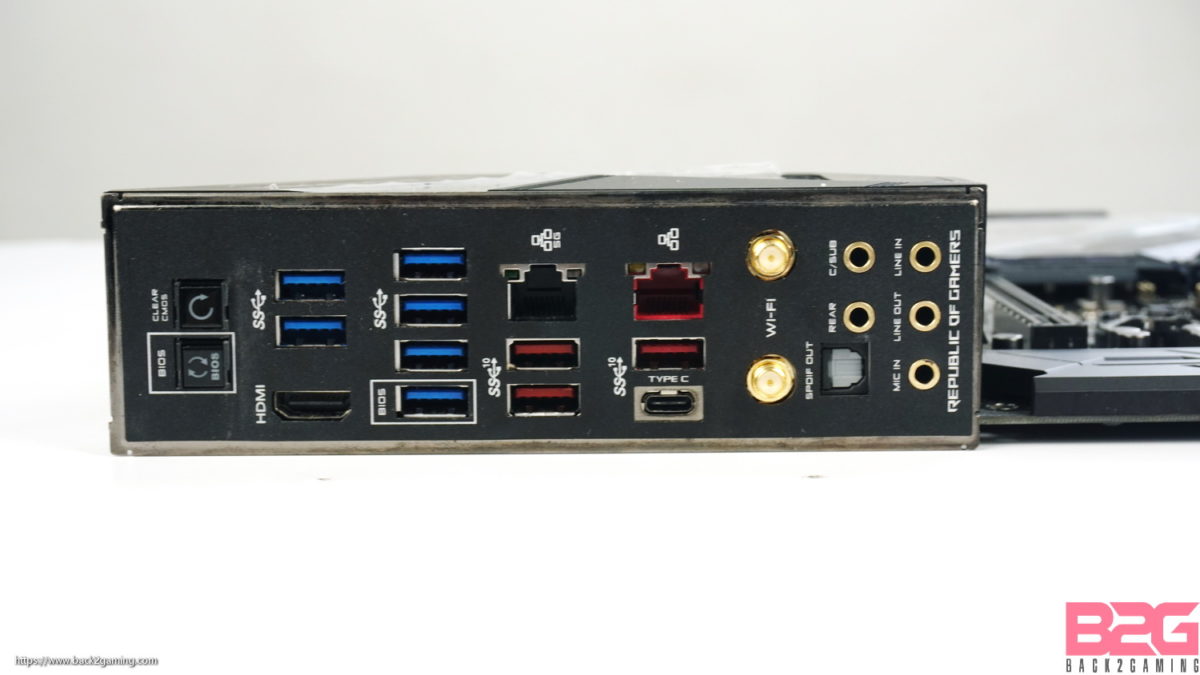
Over at the back we see a familiar layout, albeit, with a few slight changes. No more legacy PS/2 connector as ASUS swaps that out with a pair of USB3.1 ports which joins 4 more at the back. Another 4x USB3.1 Gen2 is present with one of them being a Type-C port. Two LAN ports are present, one is an Aquantia 5G LAN running of an AQC111C chip, the other from an Intel i219V. Wireless runs off an Intel WIFI-AC 9560 chip with Bluetooth 5.0 also present.
For multimedia output we have a lone HDMI port and a set of illuminated, gold-plated audio ports.
The BIOS reset and clear CMOS button are also on the back.
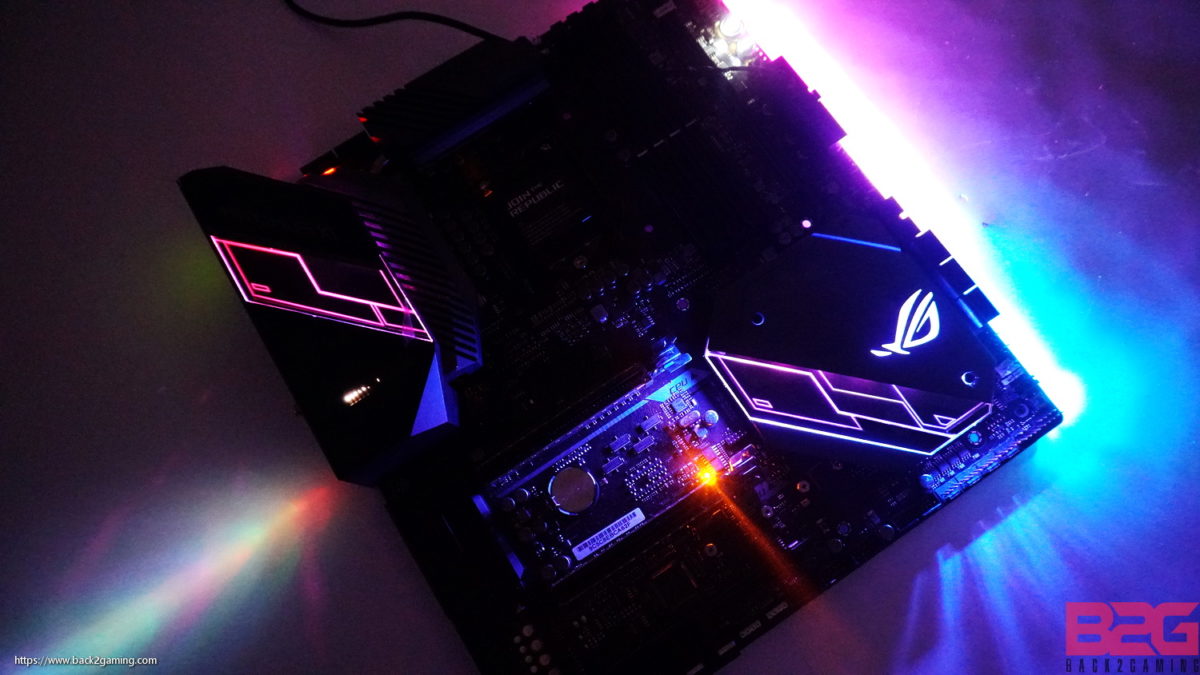
ASUS ROG Maximus XI Extreme Motherboard Review 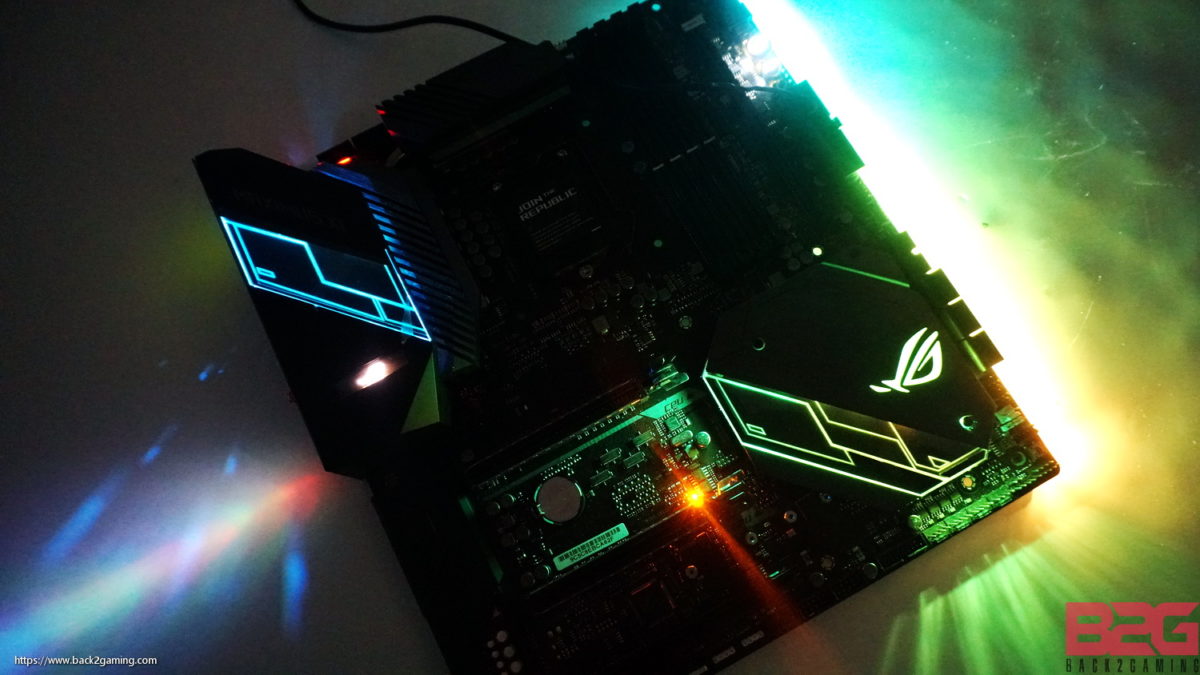
ASUS ROG Maximus XI Extreme Motherboard Review 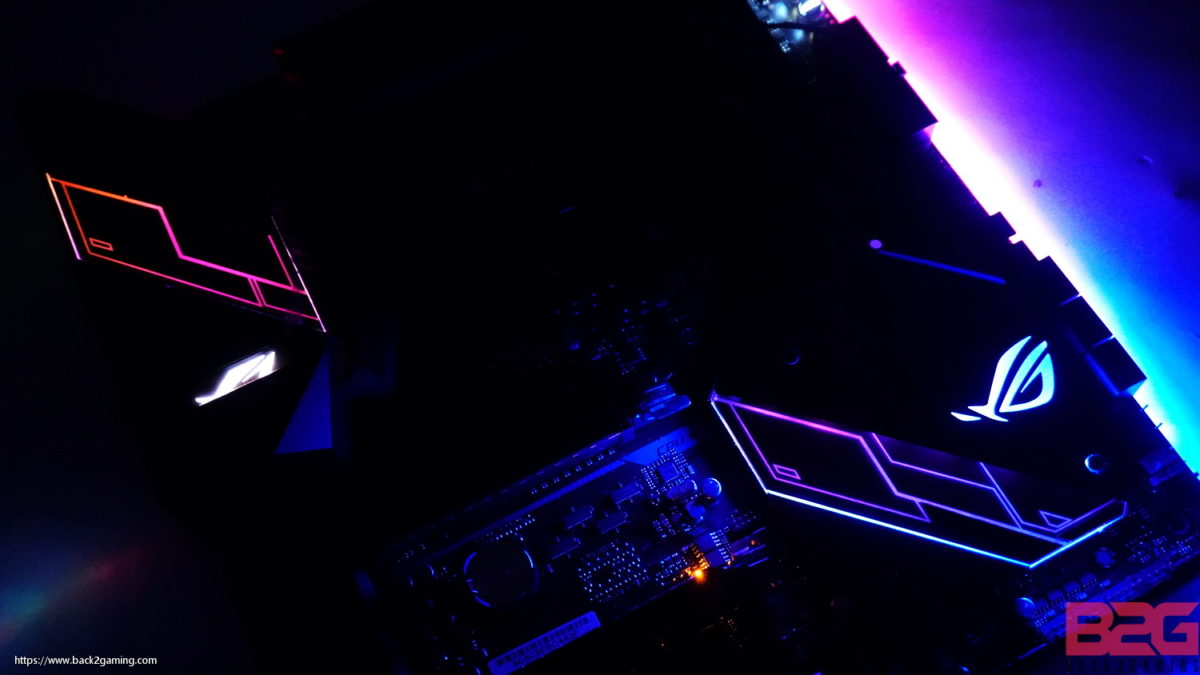
ASUS ROG Maximus XI Extreme Motherboard Review 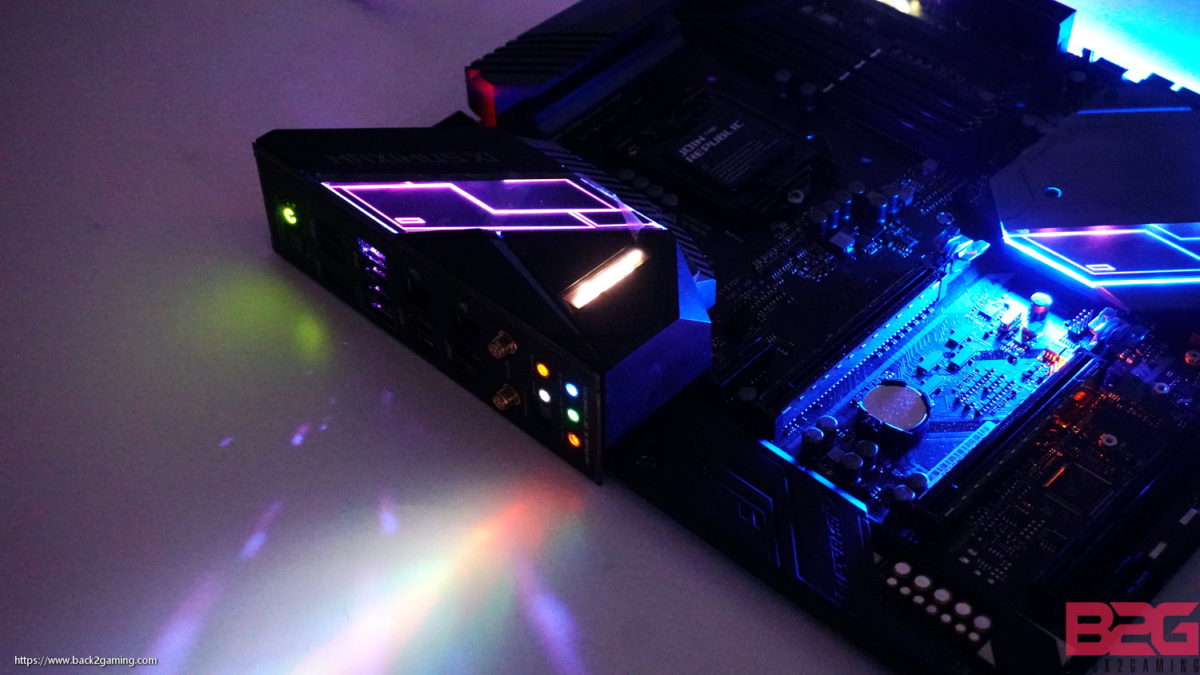
ASUS ROG Maximus XI Extreme Motherboard Review 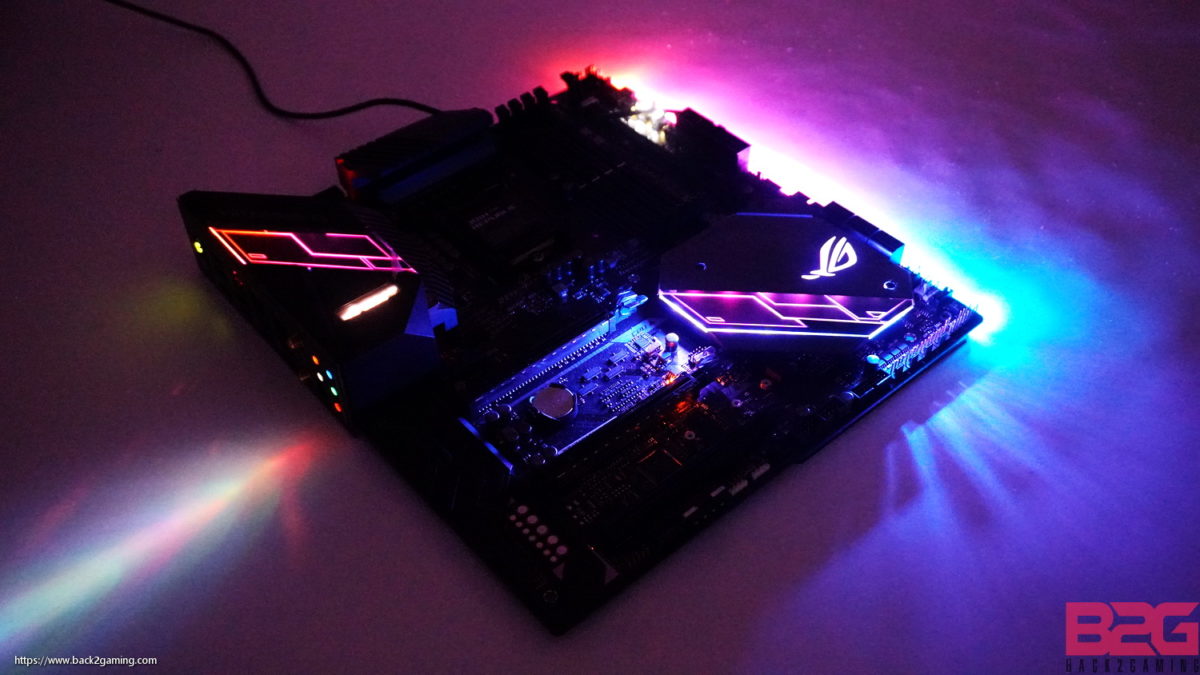
ASUS ROG Maximus XI Extreme Motherboard Review 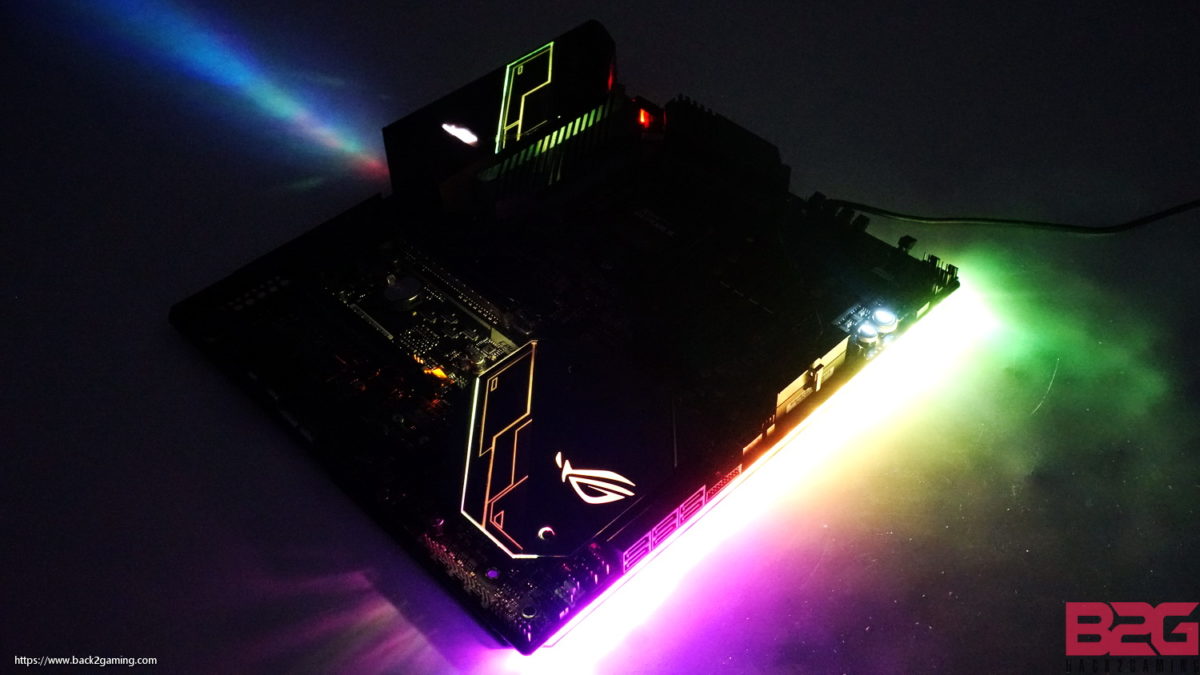
ASUS ROG Maximus XI Extreme Motherboard Review
BIOS Walkthrough
ASUS still has their familiar UEFI BIOS interface with the new Z390 motherboards. Most of these boards will share the same menu options with higher models like the Maximus XI Extreme having more menu options for extreme overclocking and tweaking. The ASUS Maximus XI Hero, Gene, etc. mostly share similar menu options.
The UEFI interface has been a mainstay for ASUS for a few generations now and we’ve praised it for being a simple yet rich at the same time. The interface is simple to navigate and offers easy-to-use dropdown menus to change values. Besides tweaking options, ASUS also integrates rich fan controls as well as voltage and temp monitoring. There’s also profile management, DRAM and PCIe viewers to check system hardware. ASUS integrates the option to update the BIOS online as well as via local storage with their interface and has been a great tool to work with.
ASUS has a BIOS flashback feature which allows users to reinstall a fresh BIOS copy in the event of an issue.
ASUS also integrates AI overclocking with their latest motherboards allowing the BIOS to gauge processor potential. In the screenshot below you’ll on the lower right the Cooler points and Silicon quality rating of the system. Intel has since voiced their concern over this and has requested ASUS to remove silicon quality. Newer BIOS will not have silicon quality in their prediction panel.
Test Setup & Methodology
Processor: Intel Core i9 9900K
Motherboard: ASUS MAXIMUS XI EXTREME
Memory: Corsair Vengeance RGB DDR4-3600 16GB
Storage: WD Blue SSD 1TB SATA
PSU: Seasonic Platinum 1050w
Cooling: Fractal Design Celsius S36 AIO Liquid cooler
Monitor: Viewsonic VX2475smhl-4K
VGA: NVIDIA GTX 1080 Ti
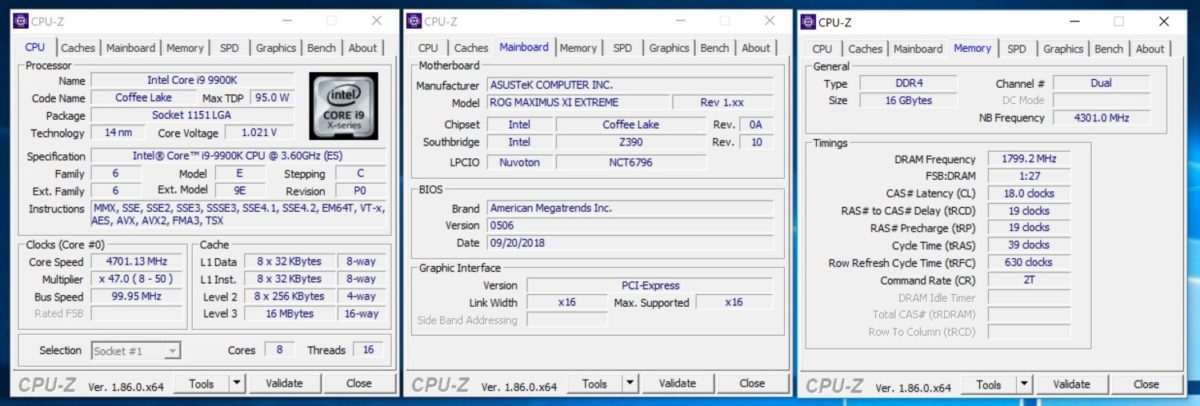
All tests are performed in an open bench with ambient room temperature kept at 28*C.
Motherboards are updated to the latest BIOS during time of testing kept at their out-of-box settings aside from XMP frequencies when running stock benchmarks.
As many already know, most motherboards will have varying frequency multipliers and this may affect performance overall. As this is part of their out of the box configuration we see it fit to use them as is. All data presented here in are with the default motherboard settings for stock performance. Overclocked performance will be indicated where needed. For non-Z series motherboards, all benchmarks are performed on DDR4-2133 default settings.
As always, we’ll let the numbers do the talking.
Best Practices
- Same thermal paste and same application method used on all cooler mounting. A pre-benchmark stress test is performed to let the TIM settle. We use Noctua NT-H1 for all our testing.
- A fresh install of Windows 10 Pro is used for every sample testing. The OS image contains all benchmarks and games. Drivers are installed after image is installed.
- An average of 3 benchmark runs is used for test sampling.
Benchmarks Used
- Maxon Cinebench R15 – Multi-threaded CPU benchmark
- Blender 3D – BMW 2.7 CPU Render benchmark
- POV-Ray 3.7.1 – Multi-threaded Render benchmark
- Cinegy Cinescore 10 – Ultra HD 4K resolution CPU encoding benchmark
- HWBot x265 – 4K x265 CPU encoding benchmark
- wPrime 1024M – multi-threaded prime benchmark
- SuperPI 32M – single-threaded prime benchmark
- GeekBench Pro 4.2 – full system benchmark
- ASUS RealBench 2.56 – full system benchmark
Subsystem Benchmarks
- Crystal Disk Mark
- Rightmark Audio Analyzer
Other Software
- Latest LAN Speed Test via LST Server
- Latest AIDA64 (Stress Test)
- Latest CPU-Z
- Latest GPU-Z
- Latest HWnfo 64-bit
Test OS Environment
- Windows 10 Pro Retail 64-bit
- Latest NVIDIA GeForce Game-Ready drivers
- Latest AMD Chipset/Radeon drivers (when applicable, AMD boards)
- Latest DirectX end-user runtime
Measuring Equipment:
- Flir One USB Thermal Camera via Thermal Imaging+ app
- HP-9800 AC wattmeter with USB interface for app logging
- Standard sound level meter
Network Hardware
- ASUS ROG Rapture GT-5300 Router
Performance Test – Rendering/Encoding
Rendering tests are benchmarks designed to gauge performance during
multimedia and professional workloads like 3D rendering or video encoding. This gives us a good idea on how a certain system will perform during a certain predefined workload.
MAXON Cinebench CPU Benchmark R15
Blender BMW Render Benchmark 2.7
wpDataChart with provided ID not found!POV Ray 3.7
wpDataChart with provided ID not found!Cinegy Cinescore 10 – Ultra HD
wpDataChart with provided ID not found!HWBot x265
wpDataChart with provided ID not found!Performance Test – Arithmetic
Arithmetic benchmarks measure the performance of systems with regards to mathematical computations which some programs require. These benchmarks paint a good picture of how raw CPU performance is like.
wPrime 1024M
wpDataChart with provided ID not found!SuperPI 32M
wpDataChart with provided ID not found!Performance Test – System Benchmark
System benchmarks measure the performance of a system based on numerous tasks including a mix of rendering, arithmetic and other things. These benchmarks require the entire system to work together and components should compliment each other to achieve maximum performance.
GeekBench Pro 4.2 Multi-Core Benchmark
wpDataChart with provided ID not found!ASUS RealBench 2.56
wpDataChart with provided ID not found!Performance Test – Memory Benchmark
AIDA64 Memory Benchmark – Read/Write
wpDataChart with provided ID not found!AIDA64 Memory Benchmark -Latency
wpDataChart with provided ID not found!Temperature & Power Draw
In this test we’ll measure how much manufacturer-set BIOS settings affect temperature and power draw. As we’re dealing with pre-launch samples, more mature BIOS may change these over time.
Temperature
Power Draw
We really don’t put too much stock on individual component temperatures as they will vary depending on usage and we do not benchmark using extreme loads anymore as they’re not reflective of real world applications. To stress the CPU, we use a 20-minute run of AIDA64 stress test. We recorded the peak CPU temps and cross-match HWINFO and AIDA64 readings. For power readings, we measure the peak system draw.
Value & Conclusion
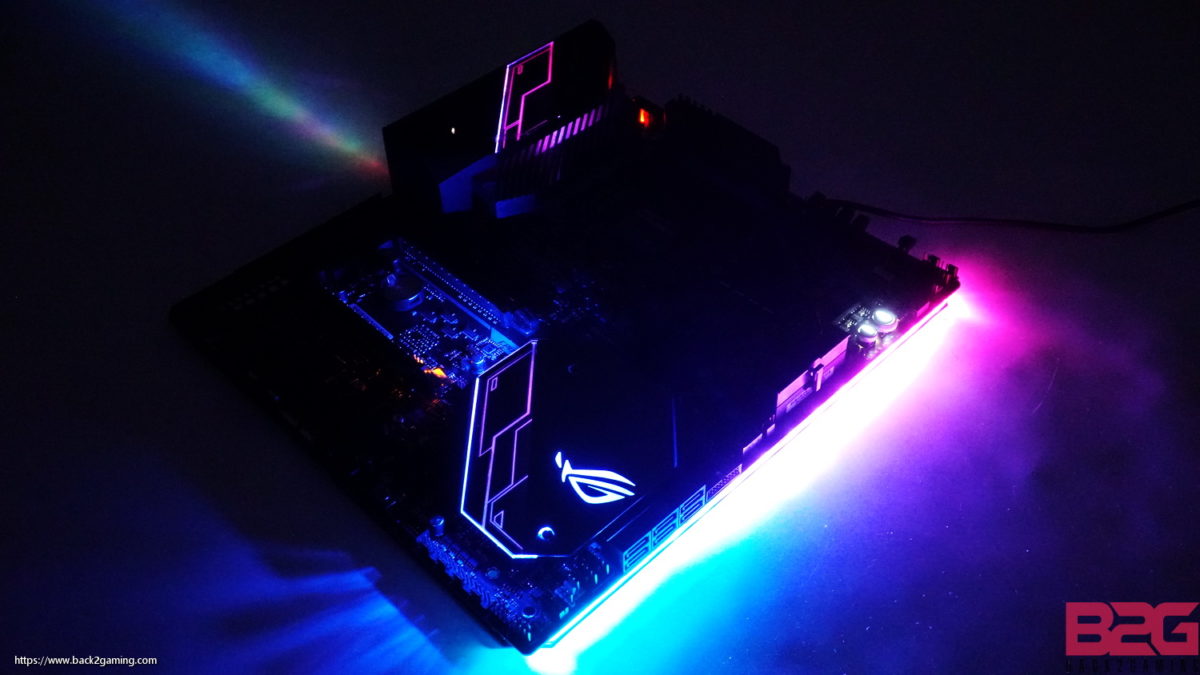
The ASUS ROG MAXIMUS XI EXTREME continues the trend wherein they have been tuning the flagship products to be more purpose-built rather than niche options. The Maximus XI Formula targets watercooling enthusiasts while the Maximus XI Extreme offers maximum scalability in terms of expansion options be it storage, graphics or connectivity. The overclocking crown has been passed on to the Apex class of products and this leaves the Extreme-class to be a full-fledged product that is not just aimed for extreme overclocking, but for actual workstations and gaming rigs that require a substantially capable foundation for the entire build.
Performance-wise, the Maximus XI Extreme doesn’t hold back the Core i9-9900K but given the chip’s complexity in achieving further overclocks, the motherboard alone isn’t enough to guarantee a good overclock. With the higher heat output of the 9th-gen i9, a good cooling solution is needed and for those looking to really go ham and max out their chip and the Maximus XI Extreme will happily accommodate a high-airflow and multi-loop watercooling loop thanks to its rich assortment of cooling fans.
High-speed storage is also addressed with ASUS allowing up to 4x M.2 slots to be utilized on the board for a high-capacity, high-speed storage installation which is required for heavy multimedia work and content creation. There’s 5-gigabit LAN and WIFI-AC for high-speed connection plus a lot of USB options.
Everything taken into consideration, the ASUS MAXIMUS XI EXTREME offers everything you need for a high-power gaming rig or workstation and gives you so much more. High-speed storage, extended OC capabilities, high-speed LAN and WIFI, everything is geared into giving the best performance you can get.
At $599 or Php31,000, the Maximus XI Extreme continues the legacy of being the priciest motherboard line in any market but with its class-leading feature set aimed at providing the best performance, this motherboard holds on to the title as the king of all Z390 motherboards.
ASUS backs the ROG Maximus XI Extreme with a 3-year warranty. We give it our B2G Gold Award!




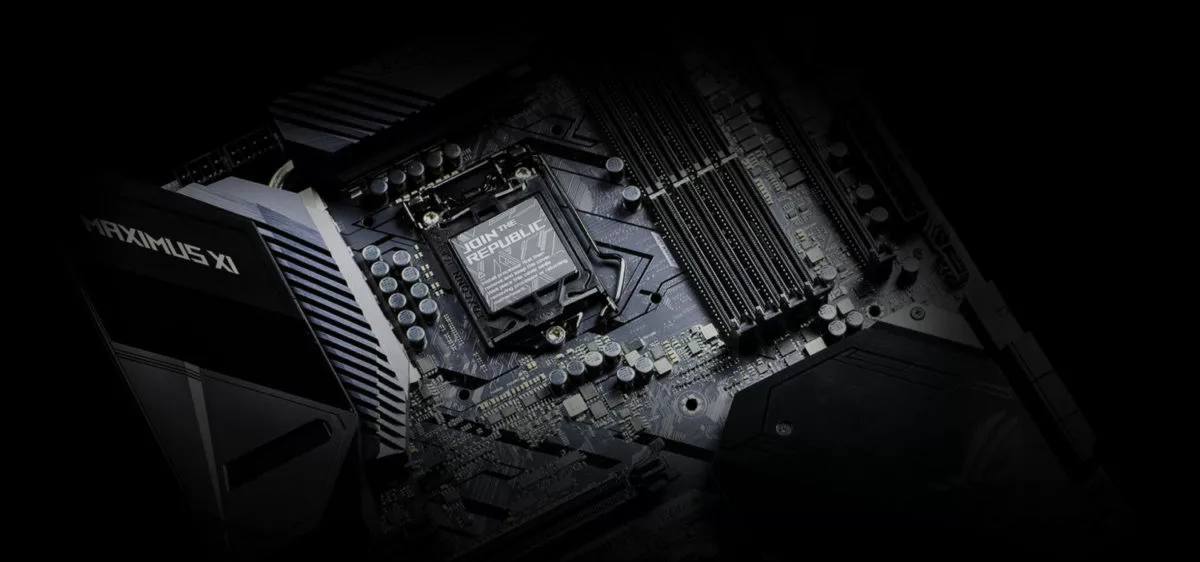
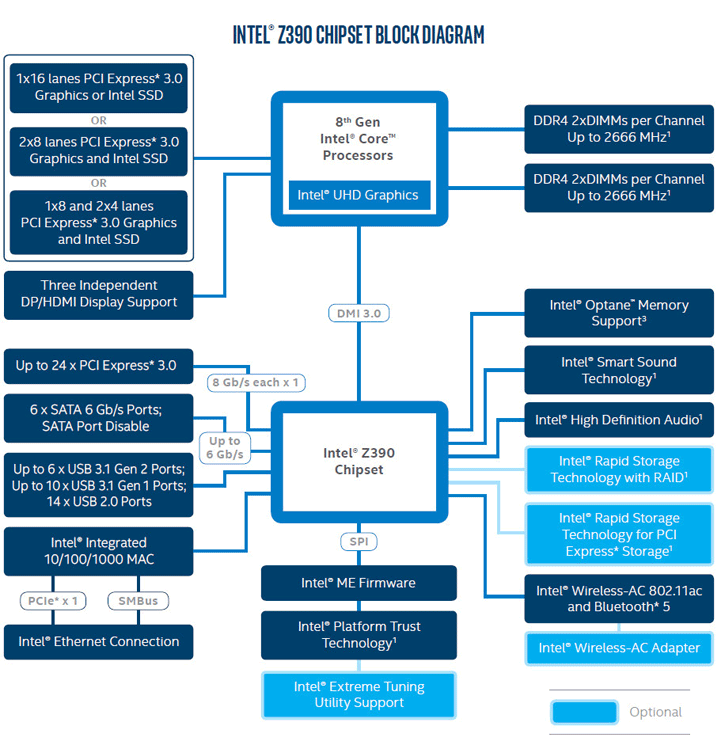
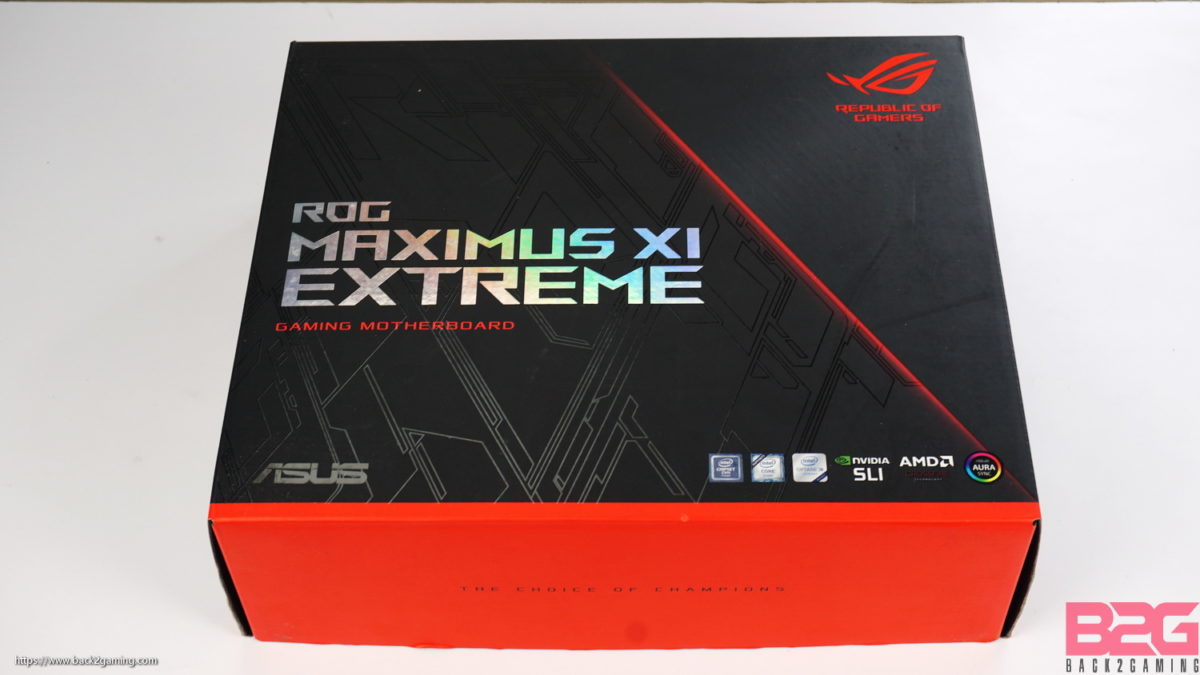
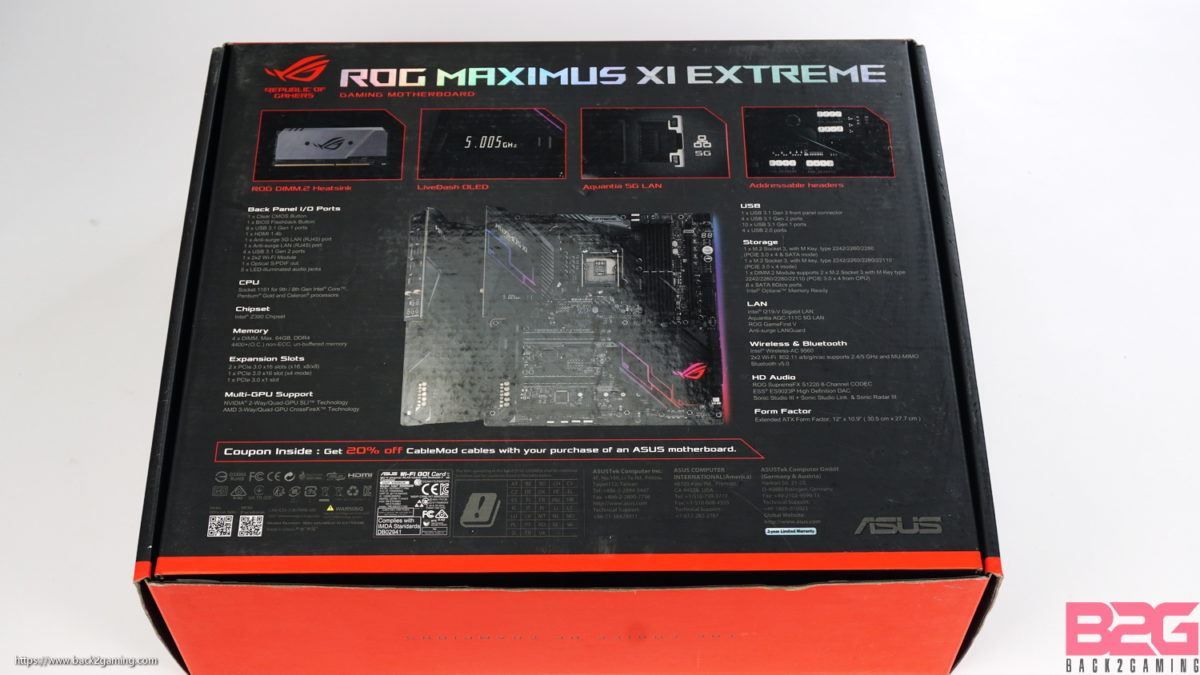
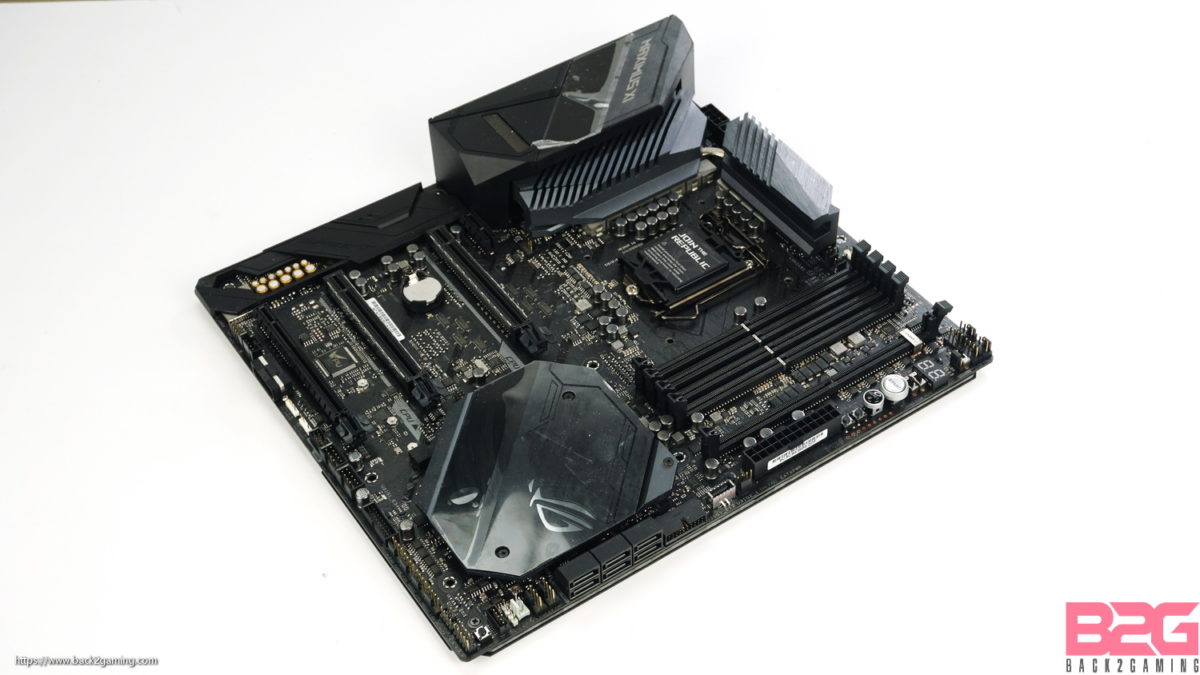
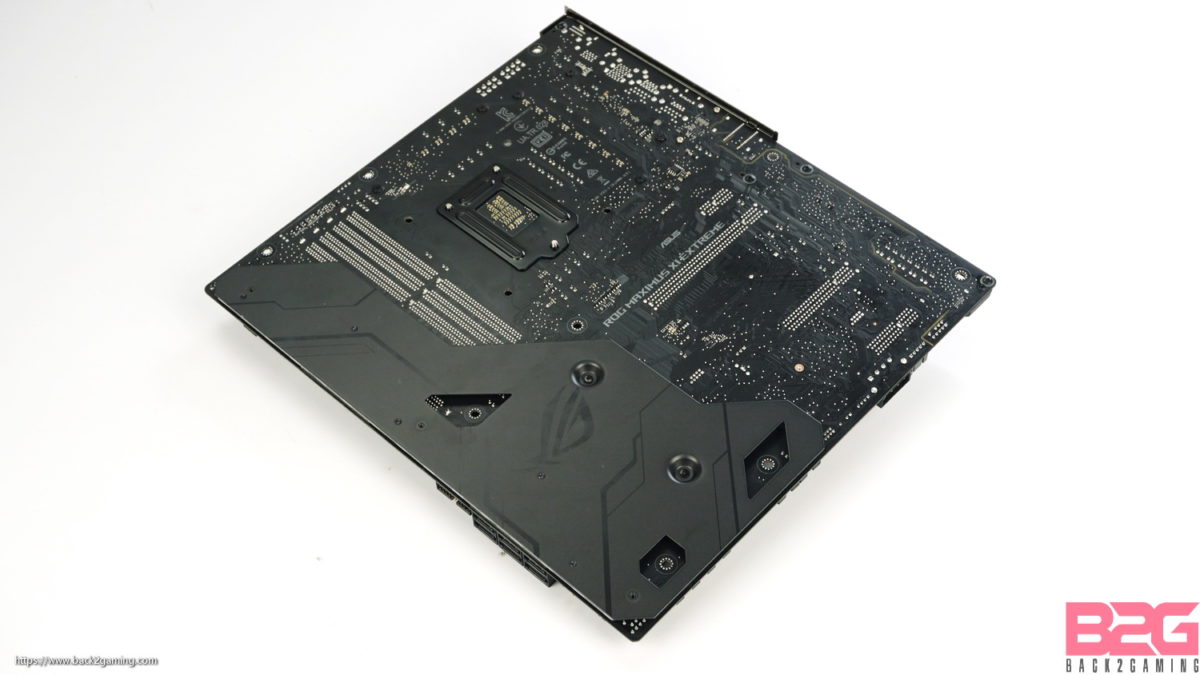
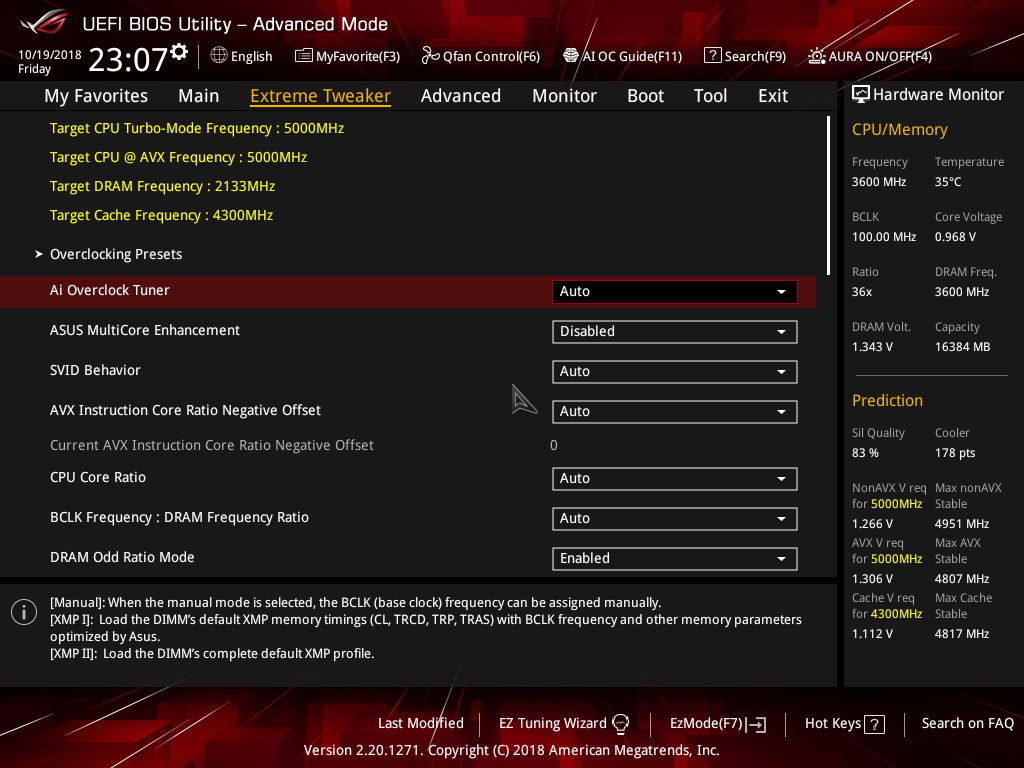
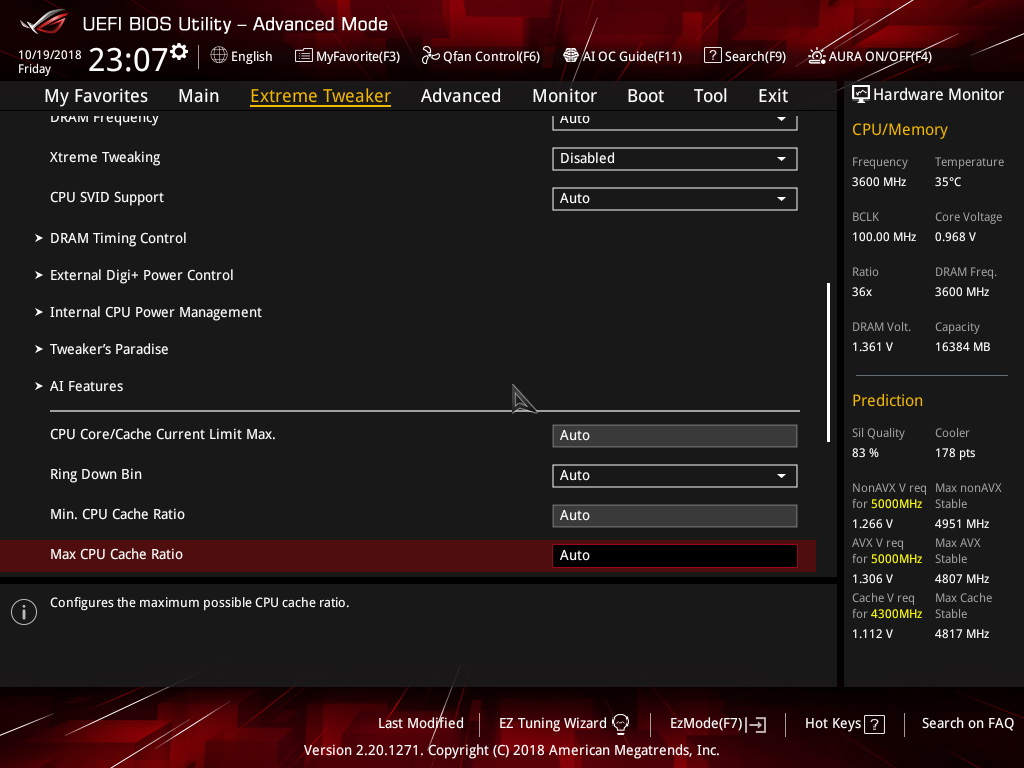
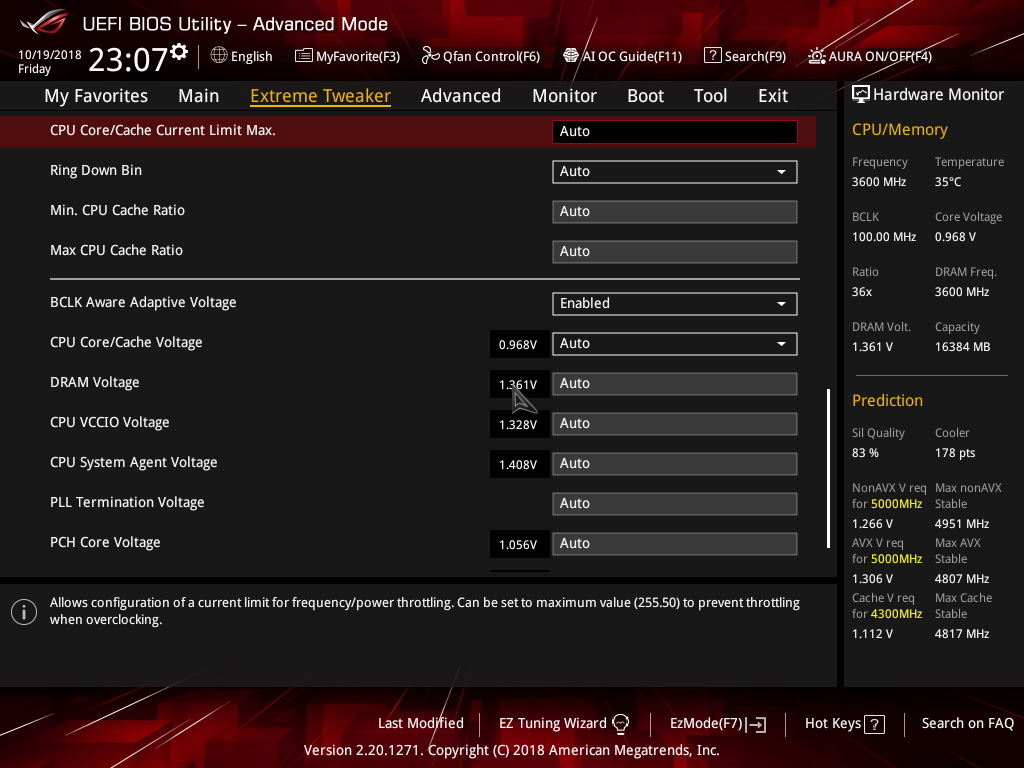
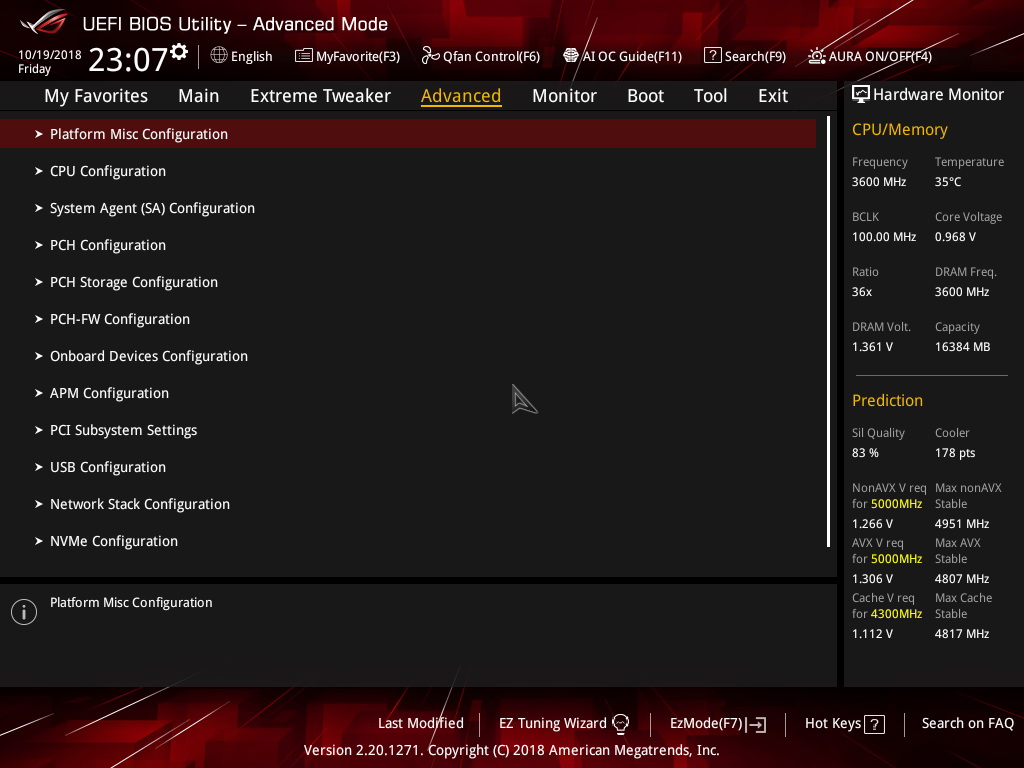
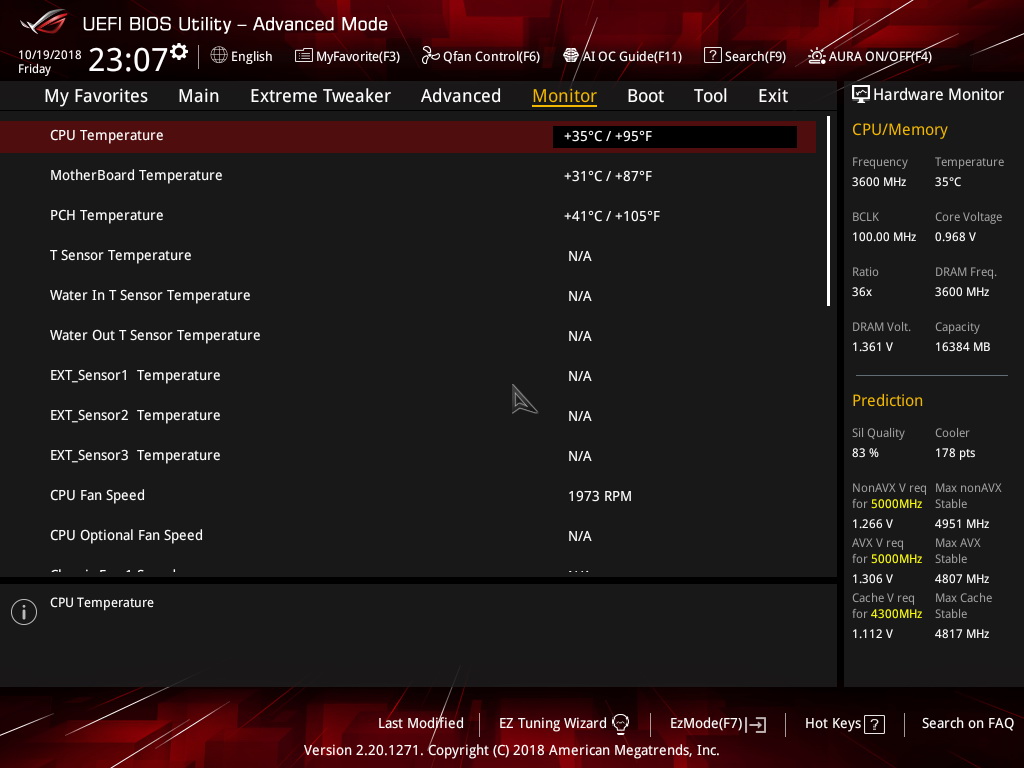
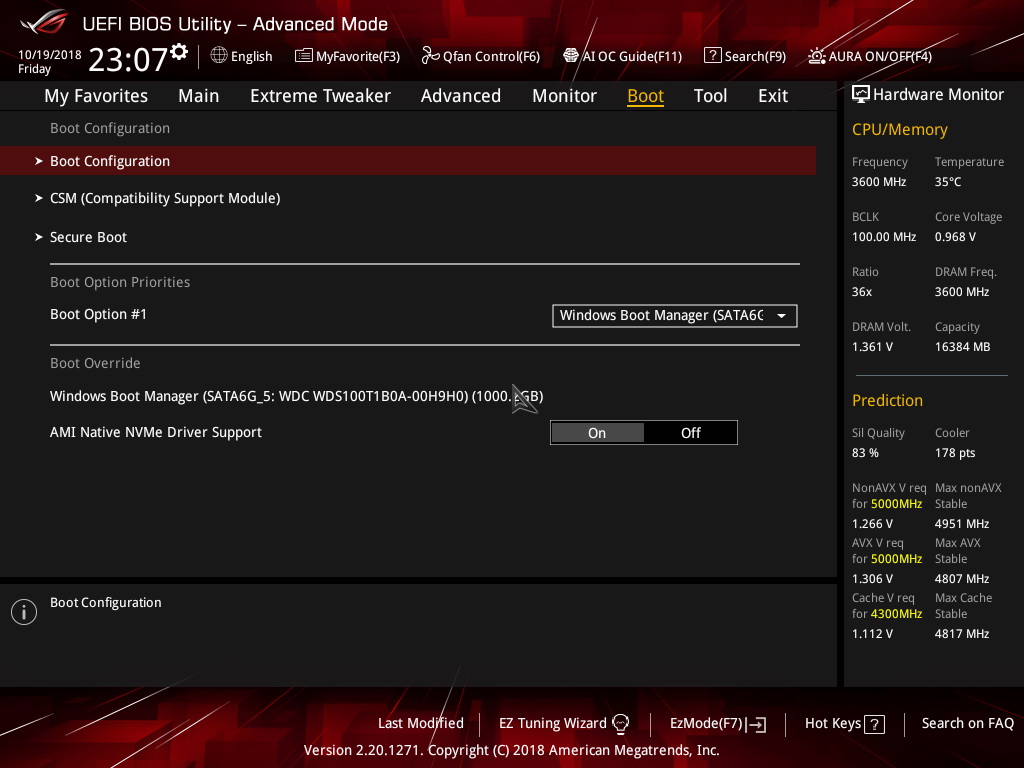
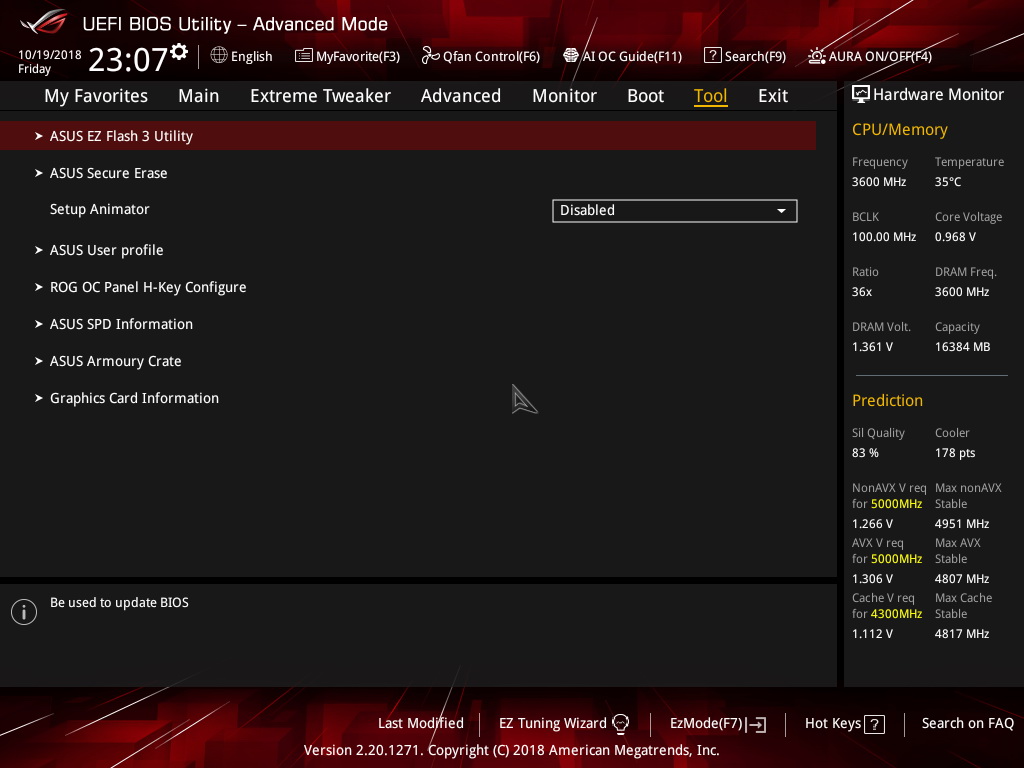
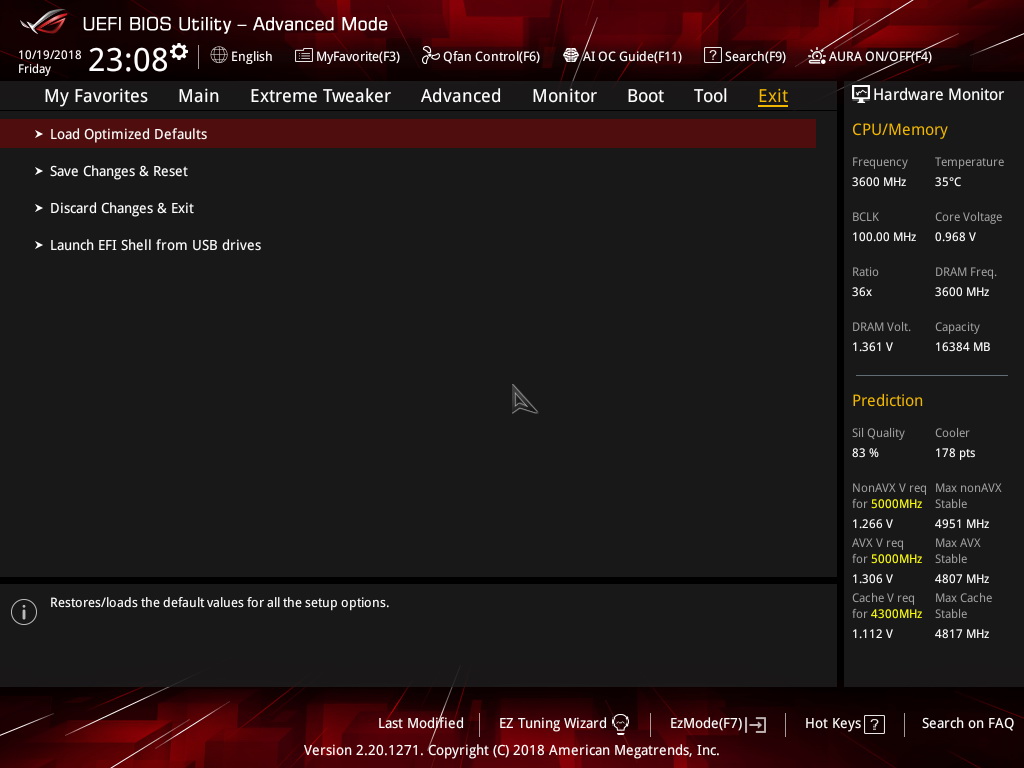
1 Comment
And the most expensive of em all?